July/August 2017 Limerick Laughs Winners and Runners-Up
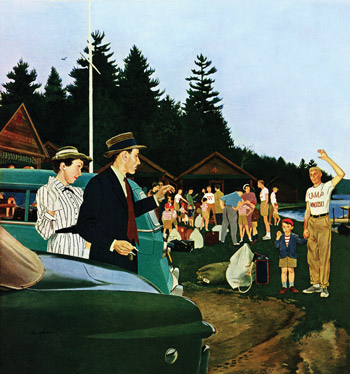
Have a good time at camp, and goodbye.
We will pick you up come mid-July.
While you fight off mosquitos,
We’ll sip on mojitos
And blast the ol’ A/C on high.
Congratulations to Jennifer Klein of Tel Aviv, Israel! For her limerick, Jennifer wins $25 and our gratitude for her witty and entertaining poem describing First Day at Camp, George Hughes’ cover from July 3, 1954.
If you’d like to enter the Limerick Laughs Contest for our next issue of The Saturday Evening Post, submit your limerick through our online entry form.
We received a lot of great limericks. Here are some of the other ones that made us smile, in no particular order:
As much as I want to enjoy it,
An issue exists that might spoil it.
Not the missing TV
Or my teddy, you see,
But the lack of a working flush toilet.—Paul Desjardins, West Kelowna, British Columbia, Canada
To his parents it’s perfectly clear:
Their boy does not want to be here.
All morning he’d fussed,
But he soon will adjust,
And be begging to come back next year.—Joyce Petrichek, Finleyville, Pennsylvania
We’ll see you the first of September.
You’re mad at us now, but remember:
If Mom gets her way,
By April or May
We’ll have a new family member.—Roger Harris, New York City, New York
The mother, she looks apprehensive.
The boy looks a little bit pensive.
And as for the dad,
I suppose that he’s mad
That this summer camp’s so darn expensive.—Neal Levin, Bloomfield Hills, Michigan
Daddy says camping is cool —
No homework, no lessons, no school.
Now I will have fun
But they will have none,
Just drinking their wine by the pool.—Bonnie Draje, Solon Springs, Wisconsin
Just think of the fun you’ll discover
At camp, while I’m home with your mother.
And if all goes to plan
We will increase our clan,
And you will come home a big brother!—Michelle Gordon, Airway Heights, Washington
Our look says, “We love you, dear one.”
We know that this camp will be fun.
Yet, while you’re away,
We grown-ups will play,
And we’ll miss you — a little — dear son.—Joan O’Kelley, Hoschton, Georgia
A boy tries his best not to cry
As his mom and his dad wave goodbye.
I don’t mean to annoy,
But which one’s their boy?
The artist does not specify.—Sam Beeson, American Fork, Utah
This seemingly heartbroken scamp
Is secretly eager for camp.
It gives him a while
To practice a style
His parents would otherwise cramp.—Jeff Foster, San Francisco, California
North Country Girl: Chapter 20 — The 60s Arrive in Duluth
For more about Gay Haubner’s life in the North Country, read the other chapters in her serialized memoir. The Post will publish a new segment each week.
In 1967, my eighth grade summer, the sixties finally trickled up to northern Minnesota. Up till then, we had existed in our own little insulated pocket of intact families, nosy neighbors, regular church-going, casual drunkenness, and a sincere belief in the virtue of conformity. Children were seen but not heard, teens were just big kids waiting to become adults, God was in his heaven, and all was right with the world.
Somewhere in the South people were marching for civil rights. Duluth had virtually no black people. We had a few grizzled Indians hanging around the liquor stores, waiting to buy booze for teen-agers in exchange for a few bucks or a can of beer. We had a handful of Jewish families, who were regarded suspiciously by my mother, although she had jumped at the chance to dump her two youngest kids in a half-day preschool at the Jewish Educational Center, where Lani, and later Heidi, learned to play the dreidel and build Sukkot tents.
Men were burning their draft cards in Berkeley and New York City; Walter Cronkite led off the news with stories of the war in Vietnam. But the college deferment was still in place, which meant that no boys who grew up in my neighborhood were at risk of being shot at by those awful Viet Cong.
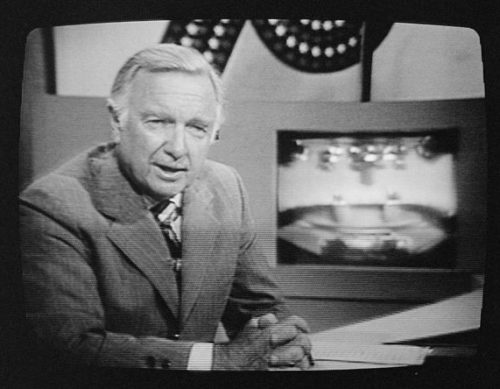
Teen culture had started to seep in with the Beach Boys. But the California world of surfing and woodies seemed as exotic to us as an Indonesian dance troupe on Ed Sullivan. Our one and only radio station, WEBC (AM of course), played Top 40 music in an indiscriminate scramble: on a 15-minute drive to the store, we would hear “Ballad of the Green Berets,” “Monday, Monday,” and “Born Free.” When the Rolling Stones’ “Let’s Spend the Night Together” came out, WEBC beeped out the title line every time, in the interest of public morality.
But cracks were opening up. Time and The Saturday Evening Post, which arrived weekly at our house, increased their coverage of civil rights and anti-war protests, and I began to tilt left. The TV shows Hullabaloo and Shindig! moved away from Petula Clark and Bobby Darrin and towards the Doors (sex!) and Jefferson Airplane (drugs!).
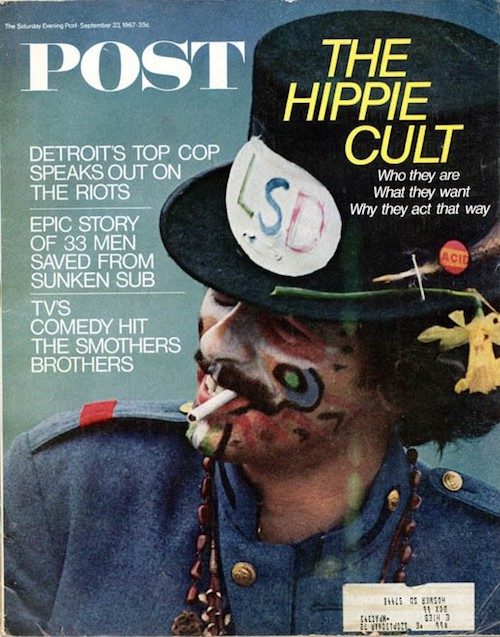
Drug culture took longer to reach us, too damn long as far as I was concerned. I had never succumbed to Beatlemania; the unwashed, sneering Rolling Stores were much more exciting. But it was mandatory that if you were between the ages of 13 and 21, you went gaga over the release of Sgt. Pepper’s Lonely Hearts Club Band. I happily joined in, hoping that by listening to “Lucy in the Sky with Diamonds” I could get an aural contact high.
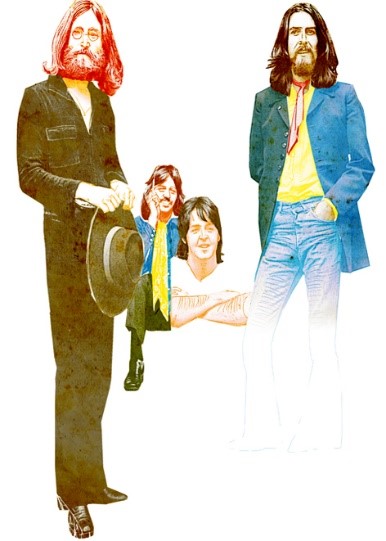
Somewhere, out in the real world, people were smoking marijuana and banana peels, ingesting morning glory seeds and LSD, expanding their consciousness in all kind of ways. But I was in a basement in International Falls, sitting around a tinny hi-fi system, with Sgt. Pepper on repeat and repeat, the record coming to a scratchy end and then flipped over, while the boy who lived there was dissolving Bayer aspirin in bottles of Coca-Cola, in an attempt to get himself and his pals, which included me but not my disapproving best friend, Wendy, high. We all claimed to feel something, although what I mostly felt was sick to my stomach.
I was huddled on that basement floor because that summer I was a long-term guest at Wendy’s grandma’s house. I had outgrown camp and the Northland Country Club pool. After the mandatory visit to Aberdeen, where I spent two weeks reading and sulking, my mother gratefully sent me north and out of her hair. International Falls was a small town, a lot like Aberdeen, but smellier, thanks to the paper mill. Wendy and I were regarded as sophisticated big city girls — “Wow, you live in Duluth!” —and welcomed everywhere. The day after the aspirin experiment, we were invited to a taffy pull at a neighbor’s, something I thought existed only in the pages of a Laura Ingalls Wilder book. My hands were buttered to the wrist, as if I were to be part of an adolescent orgy. The taffy was white and ropy and smelled of vanilla, and when finished was tooth-achingly sweet and tooth-shatteringly brittle. My father would have been horrified. I was annoyed at this wholesome party activity; I wanted to be back down in that basement, listening to records with boys and figuring out ways to get high.
I also participated in a bizarre experiment in reversing Down Syndrome. Wendy’s best friend before me had a baby sister with Down’s. I didn’t quite understand what was going on with this big-headed kid who couldn’t talk. The mom, searching for a cure, had fallen under the influence of a crack-pot theory that held that crawling was the basis of all subsequent learning. The mom spent hours manipulating her baby’s arms and legs in a swimming/crawling motion. When she got too tired she recruited anyone within shouting distance to take her place. I have no idea whether it helped or not. It was horribly creepy, moving the baby’s right arm and left leg for ten minutes, then switching to the left arm and right leg, while the kid made noises somewhere between a chortle and a howl. I hated going over to that house of sadness and madness.
The kid with the basement and the aspirin and the Sgt. Pepper’s album was International Fall’s leading Bad Boy. Wendy and I adored him. Several weeks into my visit, all of us 13-year-old aspiring juvenile delinquents were hanging out on a street corner, trying to be much cooler than we actually were. Bad Boy was smoking a cigarette (oooh!) and started lighting matches and tossing them into a red and blue mailbox. Of course, we found this, as everything Bad Boy did, hysterical. At about the twentieth match, smoke began seeping through the mailbox slot. All of us stood gazing horrified as the wisp became a serious plume, a “Yeah something is really burning” smoke signal. One of Bad Boy’s friends helpfully noted that we had probably committed a federal crime, setting the U.S. mail on fire. As the smoke darkened and streamed out of the mailbox, we fled in all four directions. Wendy and I bamboozled her poor grandma with some story about why we had to be back in Duluth immediately, and pooled our money for bus tickets, hoping to stay one step ahead of the law.
***
I got back to Duluth to find the entire teen universe abuzz. The Duluth auditorium, which had opened in 1966 and been home to hockey games, Ice Capades, and the Ringling Brothers Circus, was to have its first rock concert: Herman’s Hermits.
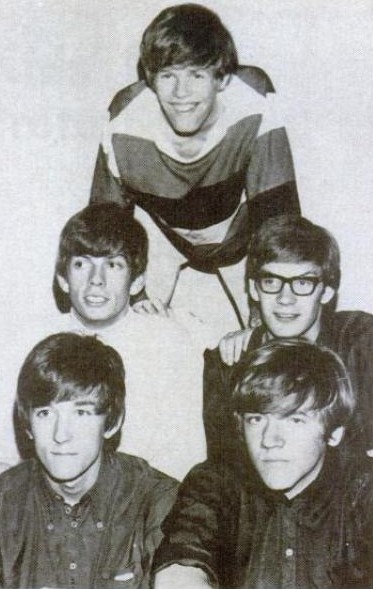
Wendy and I were speechless with joy. While Herman, aka Peter Noone, the lead singer, was almost a little too preciously adorable for my tastes (always a smile, never a sneer), he was undeniably cute. And I, like everyone under 25 in the country, had fallen under the perky, head-bobbing spell of “I’m Henry the Eighth, I Am,” which was played by the radio station at least once every hour, causing pre-teen girls to squeal, hop on one foot, and shout out “Second verse, same as the first!”
For weeks before the concert, I was lost in a whirl of daydreams where Peter Noone looked out in the audience, saw my adoring face, and fell madly in love. He would send someone out to escort me backstage, take me in his arms, kiss me, gently remove my clothes…and then stuff would happen that I was still having a difficult time imagining. I would get to that crucial point, sigh, and rewind my daydream back to the beginning.
There was only one problem. I wore glasses, thick, hideous glasses which could kill the sex drive of any boy at ten paces. I could go to the concert without wearing my brown cat’s eye with sparkles (an improvement over the baby blue ones I had worn for years) but then I wouldn’t be able to see a thing onstage. How could I catch Peter Noone’s eye if he were just a fuzzy object? I wouldn’t even be able to tell him from the lesser, unnamed Hermits.
Shindig!, the TV music show, saved me. It was on during a school night, so Wendy and I had to watch it at our own homes, one ear glued to the phone, discussing which bands and boys we liked. Shindig! had a troupe of cute girl dancers (now there was a career!). One of these dancers wore, along with her mini skirts, Mondrian-inspired dresses, and go-go boots, a pair of perfectly round tortoise shell glasses. Thanks to some mysterious seismic movement or an alignment of the stars, a pair of those exact glasses showed up at my eye doctor’s, where before my choice had been between the baby blue or shit brown cat’s eyes with sparkles. My mother, the slave to fashion, was always delighted when I paid attention to what I wore and how I looked — which was still, with my badly cut mousy blonde hair, not good. But at least with my outrageously stylish new glasses, I commanded some attention from boys, most of it a startled reaction of “Weird.”
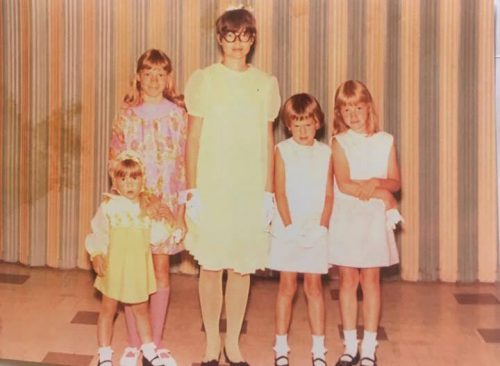
With my Shindig glasses and my own Mondrian color block mini dress, I was ready for Peter Noone to sweep me off my feet. I don’t remember what Wendy was wearing. It didn’t matter, she was only there to report back to all of Woodland Junior High that I was not in ninth grade because I had eloped with Herman.
My dad, who had been known to whistle “Henry the Eighth” himself occasionally, scored us seats a few rows from the stage. We had to sit through an opening act before Herman’s Hermits came on. That band was The Who. I had heard “I Can See for Miles” on WEBC a few times the winter before, enjoyed it, but relegated The Who to the category of British Bands I Kinda Liked: The Kinks, The Animals, The Zombies.
Seeing The Who live rocked my little Duluthian world. There I was, nicely dressed, waiting to see that sweet young man who politely told Mrs. Brown she had a lovely daughter. I got Roger Daltrey’s unhinged vocals (ooh, he was really cute!), Keith Moon’s spastic flailing over his drums, and Pete Townsend smashing his guitar on the stage floor over and over (and John Entwhistle noodling about in the background). The Who killed off any residual Minnesota nice girl in me and I was pitched head first into full-fledged Youth in Revolt. At the end of “I Can See for Miles” Townsend stomped offstage with the splintered neck of his guitar in hand while everyone around me politely applauded while muttering “Were they on drugs? What was that all about?” I knew what it was about, it was about smashing the old to make way for something completely new, whether the world or Duluth or Woodland Junior High was ready for it or not.
The crowd stood and roared when Herman’s Hermits took the stage; I was still in a daze; sorry Peter Noone, you are no longer my type.
Humorists on Humor: Cracking the Code on What Cracks Us Up
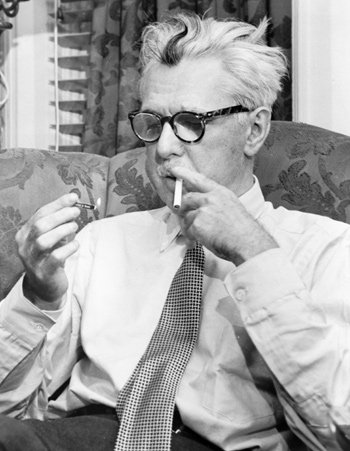
World Telegram & Sun Photo by Fred Palumbo/Library of Congress
One of the most popular writers of his day, James Thurber was, to use his own words, a wit, satirist, and humorist. As he explained, “The wit makes fun of other persons; the satirist makes fun of the world; the humorist makes fun of himself.” Named for him, the Thurber Prize for American Humor is awarded annually to recognize the art of humor writing; the 2017 winner will be announced at Caroline’s Comedy Club in New York City on October 2, 2017. The Post invited previous prize winners and finalists to share thoughts on the art of being funny today.
What characterizes modern American humor?
“People talk about the perils of being politically correct, but in a way it’s just the opposite. There’s so much more you can say now than you could 30 years ago. Louis C.K.’s comedy routines are a case in point, but there are writers who push the envelope just as far. What used to be on the edge is now family humor.”
—Calvin Trillin
Novelist, poet, food writer, regular contributor to The New Yorker; author of Quite Enough of Calvin Trillin
“I tend to write political satire. But I decided that American politics have reached the point of being sufficiently self-satirizing, so for my recent book, The Relic Master, I travel backward in time to the year 1517. And you know, I had such a good time doing it I may just stay in the 16th century. And while it’s probably true that a lot of the comic/satirical energy has shifted to TV, there’s still an awful lot of good stuff being written these days.”
—Christopher Buckley
Novelist, essayist, critic, memoirist; author of No Way to Treat a First Lady
“Humor is less filtered now than it used to be, it’s darker, more inappropriate, but at the same time humor with heart reigns supreme. It’s hard to characterize the humor scene today because it’s so diverse. It’s become a conduit for political issues, for social, class, and gender issues. Is it possible ‘funny’ is getting too ‘serious’? People still want to laugh, but they also want a really good story to go along with it.”
—Sloane Crosley
Essayist, novelist; author of I Was Told There’d Be Cake
What qualities does good humor writing have, and can it be learned?
“Essentially, you take an essential truth and twist it, turn something upside down so it’s seen in unexpected ways. That’s the heart of it. Afterward, there are matters of timing and pacing, a rhythm you need to establish. Throw in some elements of storytelling. Build up, push back, build the tension, and finally you hit the mark. I used to think humor couldn’t possibly be learned, but now I absolutely believe it can. ”
—Laurie Notaro
Journalist, novelist; author of The Idiot Girl and the Flaming Tantrum of Death
“I don’t know how Thurber would do these days. His agent would probably tell him he needs to get a sitcom before he can shop his book around.”
—Dan Zevin
“I think you can analyze what makes good humor. And you can sum up techniques of how to make it work. But something like that would end up in the Journal of Structural Engineering. It would be that dull.”
—John Kenney
Novelist, regular contributor to The New Yorker; author of Truth in Advertising
Where does humor come from? Is there a humor impulse?
“I don’t think it’s a humor impulse. It’s a story impulse. After the idea comes to you, you have to think what form it will work best in — a short piece, a novel, the theater, late-night TV show. I’m blessed that I’ve been able to work in all those forms, so I can decide which one works the best. Maybe next I’ll try writing a pamphlet.”
—Alan Zweibel
Screenwriter (Saturday Night Live), playwright, novelist; author of The Other Shulman
Do you find humor comes out of your own experiences?
“Of course, although I had trouble finding anything funny about turning 80. At least I don’t have to take my shoes off at the airport anymore.”
—Calvin Trillin
Do you see any difference in the humor between men and women?
“I think men and women are equally funny, but because men’s experiences are way different from women’s, it makes for a difference in perspective. That makes us different but equal in a number of ways.”
—Laurie Notaro
“Tina Fey and Lena Dunham have both written staggering, laugh-out-loud funny books. Many of the funniest people writing today are women.”
—John Kenney
Do the internet and social media have an impact on contemporary humor?
“I find a lot of cool, interesting voices on the internet that you won’t find anywhere else. You can publish and reach an audience there that you can’t anywhere else. That means that someone in Minnesota who works at a power company can publish short pieces of comedy that people anywhere in the world can find and laugh at. Through the internet, the sky’s the limit as far as creativity.”
—Steve Hely
Screenwriter (30 Rock, The Office); Author of How I Became a Famous Novelist
Would you consider the humor on American television to be literary in its broadest sense?
“Only written humor, written by one person, published on paper, in a book or magazine, is literary humor. TV sitcom scripts, screenplays, blog posts, transcripts of stand-up routines are all fine, but none come close to literary humor. Every so often, a work of literary humor lasts forever. A few pieces by Thurber fall in that category. Ditto S.J. Perelman and Robert Benchley. Roy Blount is a great literary humorist, as are Garrison Keillor and David Sedaris.
—Ian Frazier
Essayist, staff writer at The New Yorker; author of Lamentations of the Father
“From a book-publishing perspective, I think humor writing is in great shape, just as long as you’re a famous TV star. I don’t know how Thurber would do these days. His agent would probably tell him he needs to get a sitcom before he can shop his book around town. Or at least he’d need an Instagram account. He’d probably be taking selfies with his dogs instead of drawing them.”
—Dan Zevin
NPR contributor; author of Dan Gets a Minivan: Life at the Intersection of Dude and Dad
Laugh Lines
On Parenting: “Parenthood is an amazing opportunity to be able to ruin someone from scratch.”
—Jon Stewart
On Social Media: “Getting your news from Twitter is like asking a cat for directions.”
—Andy Borowitz
On Politics: “Politicians and diapers must be changed often, and for the same reason.”
—Mark Twain
On Marriage: “Never marry a man you wouldn’t want to be divorced from.”
—Nora Ephron
On Religion: “Anyone who thinks sitting in church can make you a Christian must also think that sitting in a garage can make you a car.”
—Garrison Keillor
On Taxes: “Tax reform is taking the taxes off things that have been taxed in the past and putting taxes on things that haven’t been taxed before.”
—Art Buchwald
On Women: “Women are wiser than men because they know less and understand more.”
—James Thurber
On Death: “That would be a good thing for them to cut on my tombstone: Wherever she went, including here, it was against her better judgment”
— Dorothy Parker
News of the Week: Buttered Rolls, Marilyn Monroe, and Rockwell at the Swimming Hole
Only in New York?
Another week, another controversy that breaks the internet. Sometimes you can see them coming, like that Google manifesto that has the left and the right taking sides, or weird/funny videos that go viral. But sometimes something takes over the web that you could never predict, like that dress a couple of years ago that no one knew the color of (I knew it was black and blue!) Yes, there was a day when everyone online was arguing about the color of a dress.
Now we have a new controversy: buttered rolls!
This New York Times piece by Sadie Stein extols the virtues of the buttered roll, which she and many other people say is a thing unique to New York City. Now, you might have the same first reaction that I and many other people online had: Can’t you get buttered rolls, well, everywhere?
Apparently not! Not like the ones in New York! To be fair, it seems like Stein’s talking about a certain type of roll (a big hard roll with butter in the middle, almost like a butter sandwich) that you get in certain places, like bodegas and carts and delis, and you eat it for breakfast with your morning coffee. I’ve never had one of these, but they still seem like, you know, a roll with butter. I’ve had a lot of those.
This paragraph stands out:
Though of course bread and butter are eaten all over, the buttered roll (or roll with butter, as it is known in parts of New Jersey) is a distinctly local phenomenon. Mention its name outside the New York metropolitan area and you would very likely be met with blank incomprehension.
I very much doubt that, even if our buttered rolls aren’t “buttered rolls.” But what do I know? The article has a lot of defenders, including Stein’s New York Times cohort Pete Wells, and detractors, like BuzzFeed’s Tom Gara. Stein knew there would be people who didn’t understand:
In response to inevitable carping…yes, NYers are incurable solipsists. AND the specific buttered roll discussed here is a specific thing.
— Sadie Stein (@SadieStein) August 2, 2017
David Letterman Is Back!
I knew he wouldn’t stay away. As soon as I heard him talking about how he wished he had thought of Comedians In Cars Getting Coffee and noticed that he had started to do more interviews and podcasts, I knew he would be the anti–Johnny Carson and actually come out of retirement to do another show. Letterman just signed with Netflix to do six episodes of a new talk show starting in 2018. Instead of many guests, Letterman will sit down with one guest for the entire show. I’m thinking it’s going to be more Charlie Rose, less The Late Show.
But Dave, please, shave off that beard.
Speaking of Netflix…
Pop quiz: Who’s going to play Lucille Ball in a new biopic Aaron Sorkin (The West Wing, The Social Network, A Few Good Men) is writing for the streaming service?
- Cate Blanchett
- Meryl Streep
- Debra Messing
- Tea Leoni
- Amy Adams
Here’s the answer. Now we can all make our predictions on who should play Desi Arnaz.
Does America Have a Tattoo Problem?
I was watching an episode of The Dick Van Dyke Show a while back. Sally was telling Rob and Buddy that she would date a guy who had a mustache even though she never liked them before. She then said the next thing she was going to be into was tattoos, which shows how rare it was for men to have them back then (unless you were in the military).
How times have changed. You can’t leave the house without seeing at least one man (or woman) who has at least one tattoo. This piece at The Federalist argues that America has a tattoo problem.
I’ve never been tempted to get a tattoo. I did think about getting my ear pierced for about five minutes back in the ’80s. I’d have to get a really subtle tattoo, small and in a place no one could see it, because, well, they can get out of hand.
A Modern-Day Norman Rockwell Painting
This is proof that Twitter isn’t completely annoying: a photo taken at a recent Boston Red Sox game at Fenway Park that could pass, as Maury Brown says, as a Rockwell:
This is an absolute modern day Norman Rockwell painting. pic.twitter.com/SxYF6JRkof
— Maury Brown (@BizballMaury) August 4, 2017
RIP Glen Campbell, Barbara Cook, Robert Hardy, Don Baylor, Darren Daulton, Daniel Licht, Ty Hardin, Haruo Nakajima
Glen Campbell not only performed such classic songs as “Wichita Lineman,” “Rhinestone Cowboy,” and “Gentle on My Mind,” he was also a member of the famous group of session musicians known as The Wrecking Crew and played guitar on many other songs, including The Beach Boys’ “I Get Around” and “Help Me, Rhonda,” Ricky Nelson’s “Hello, Mary Lou,” Wayne Newton’s “Danke Schoen,” and Frank Sinatra’s “Strangers in the Night.” He died Tuesday after a battle with Alzheimer’s Disease. He was 81.
Barbara Cook was the Broadway soprano who won a Tony for The Music Man and appeared in other classic musicals like Candide and She Loves Me. She passed away Tuesday at the age of 89.
Robert Hardy was a veteran actor who played Cornelius Fudge in the Harry Potter movies and appeared in many other movies and TV shows, including several in which he portrayed Winston Churchill. He died last Thursday at the age of 91.
Don Baylor and Darren Daulton were two baseball favorites who passed away this week. Baylor was not only the 1979 MVP, he led the league in getting hit by pitches: seven times in his career. He died Monday at the age of 68. Daulton was an All-Star catcher for the Philadelphia Phillies. He died Sunday at the age of 55.
Daniel Licht did the music for Dexter and many other TV shows and films. He died last Wednesday at the age of 60.
Ty Hardin played Bronco Layne on the 1958–62 CBS Western Bronco and also appeared in movies like PT 109, The Chapman Report, and Merrill’s Marauders. He died last Thursday at the age of 87.
You wouldn’t recognize Haruo Nakajima because his face was usually hidden inside a suit. The Godzilla suit, to be exact. He was the first person to put it on and stomp around Japan in 1954 and played the monster in 11 more films. Nakajima died Monday at the age of 88.
This Week in History
Marilyn Monroe Dies (August 5, 1962)
The last professional photos of Marilyn Monroe, taken by George Barris three weeks before her death, went up for auction this week. The auction ends at 12:07 p.m ET today, so get your bid in quick.
President Nixon Resigns (August 9, 1974)
Nixon was really excited about taping his Oval Office meetings for posterity, but the practice eventually led to this:
This Week in Saturday Evening Post History: “Swimming Hole” (August 11, 1945)
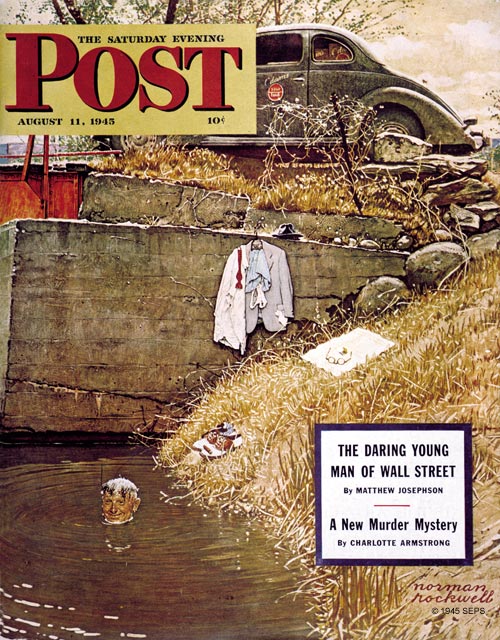
Norman Rockwell
August 11, 1945
© SEPS 1945
Here’s an actual Norman Rockwell cover, one where he shows a salesman taking an impromptu dip on a hot summer day. I’m trying to find his pants, though. I see his shirt, jacket, tie, shoes, and even glasses, but I can’t find the pants.
Paninis
August is National Panini Month. Food Network has 50 panini recipes you can try, which means you can have two every day for the rest of the month without repeating a recipe. If you don’t own a panini press, you’ll have to use a heavy pan to press it down in the skillet.
If a panini is too much work for you, you could just make a regular, old-fashioned sandwich, because it also happens to be National Sandwich Month. You could even have a sandwich on a roll.
You know, with butter.
Next Week’s Holidays and Events
International Left Hander’s Day (August 13)
If you’re right-handed and have always looked at left-handers as “different,” Sunday’s the day you can treat them as if they were normal.
National Roller Coaster Day (August 16)
I’m not a roller coaster fan. I’ve been on one, years ago at Canobie Lake Park in New Hampshire, and I’ll never go on one again. But National Roller Coaster Day is the day to get on one and ride it again and again and again.
News of the Week: Wonder Woman, Watergate, and Way Too Many People Confused about Chocolate Milk
In Her Satin Tights, Fighting for Her Rights (To Equal Pay)

I’m sick of hearing about all of this “fake news” nonsense, but one story appeared this week that might actually deserve that title.
It all started with a Forbes story from 2016 about the making of Batman vs. Superman, which was reinvigorated by a new story at The Daily Dot. Supposedly, Wonder Woman star Gal Gadot only made $300,000 for her role, while Henry Cavill got $14 million for his role as Superman. That’s unfair! That’s sexist! Where’s the equality? Why do female stars have to put up with making only a fraction of what their male counterparts make? They both wore colorful costumes!
You can probably tell where this story is going. It turns out to be not true. That $14 million number for Cavill was based on a number from another website (are you following this?) that said Cavill’s entire net worth was $14 million. The exact amount that Cavill made is unknown, but you can pretty much rest assured that it’s closer to what Gadot made.
It’s amazing how fast an obviously bogus meme can spread on social media.
But whatever actors get paid, Daniel Day-Lewis won’t be getting it. He has quit acting altogether.
RIP John Avildsen, Stephen Furst, and Bill Dana
John Avildsen directed several films, including the first and fifth Rocky movies, three Karate Kid movies, Save the Tiger, and Lean on Me, as well as many others. He died last Friday at the age of 81.
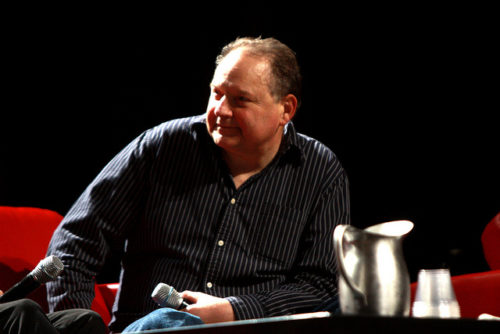
Gage Skidmore / Flickr.com
Stephen Furst was probably best known for playing Flounder in Animal House and for his role as Dr. Axelrod on St. Elsewhere. He also had regular roles on Babylon 5 and Buzz Lightyear of Star Command and appeared in many other movies and shows. He passed away last weekend at the age of 63.
Bill Dana was a comic actor who had his own show in the 1960s called The Bill Dana Show. He created the “Jose Jimenez” character seen on such shows as The Steve Allen Plymouth Show and The Ed Sullivan Show. He performed with people like Frank Sinatra and Don Adams, wrote the “Would You Believe?” jokes for Adams on Get Smart, and wrote for other TV shows, including the famous All in the Family episode where Sammy Davis Jr. kisses Archie. He died last week at the age of 92.
Does Chocolate Milk Come from Brown Cows?

Well … no. No it doesn’t. But according to a new study by the Innovation Center of U.S. Dairy, 7 percent of American adults think that it does. And if you think that 7 percent isn’t a lot, it comes out to over 16 million people.
I really don’t know what to say, except to point out that monkey bread isn’t really made by (or of) monkeys, and tomatoes aren’t all grown by a guy named Tom.
Now I have to wonder where people think a Black Cow comes from.
New York City: 1911
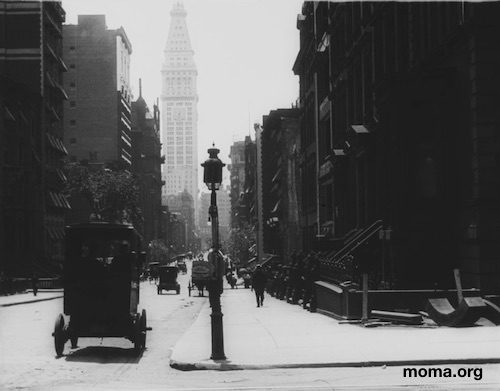
The Museum of Modern Art (or MOMA) has posted at their website restored footage of New York City taken in 1911. You can see the Statue of Liberty, Broadway, the Flatiron Building, the Bowery, Battery Park, Madison Avenue, and other famous locations.
I’m always fascinated by the people in these videos, just ordinary citizens going about their day. Who were they? What did they do? What happened to them? Could I be related to anyone in the video or know someone who knew them? At one point, a one-legged guy on crutches walks toward the camera. What’s his story?
The video was taken by a Swedish company that also filmed at Niagara Falls and cities like Paris and Venice.
Real Athletes, Fake Steroids
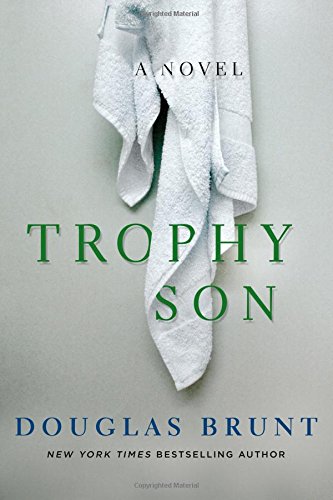
Megyn Kelly has been in the news the past few weeks. Her new Sunday Night with Megyn Kelly show on NBC debuted with big interviews (even if the ratings weren’t as big). Her husband is novelist Douglas Brunt, and he might be making his own news because of what he says in his latest book.
The novel is called Trophy Son, and it’s about the pressures that a teenage tennis prodigy is getting from his father and others to become number one. Since it’s a novel about pro sports, performance-enhancing drugs are part of the plot. But Brunt made an interesting decision. He names real tennis stars, including Rafael Nadal, Novak Djokovic, Andy Murray, and David Ferrer and has a fictional trainer strongly imply that they have either used performance-enhancing drugs or have been investigated for using them. Needless to say, this could be a little … controversial?
Brunt says he doesn’t mean to imply that he thinks these players actually use the drugs; he just wanted to use real names to make the novel more realistic.
50th Anniversary of the Summer of Love and Monterey Pop
Besides the extensive coverage that you’ll find in our current issue of the music and culture of 1967 and the festival that many call the birthplace of rock festivals, CBS Sunday Morning did a report on the Monterey Pop Festival this week:
This Week in History
Watergate Break-In (June 17, 1972)

Watergate has been in the news a lot lately, partly because many news organizations are finding parallels to current investigations, but mostly because it’s the 45th anniversary of the break-in. When I was a kid, I had no idea what the word Watergate referred to. I didn’t even know it was a hotel until many years later.
Julius and Ethel Rosenberg Executed (June 19, 1953)
The two sons of the married couple executed for spying have been trying to clear their names.
This Week in Saturday Evening Post History: “Bicycle Tricks” (June 18, 1955)
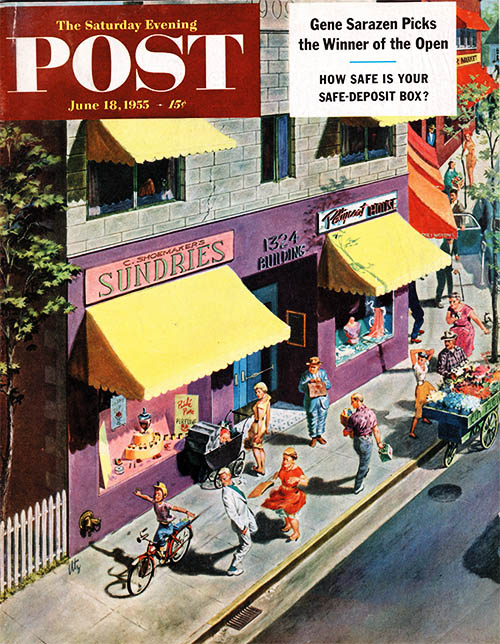
Thornton Utz
June 18, 1955
I always say I love old Saturday Evening Post covers, but I really do. I enjoy looking closely at the various people and activities in the paintings to see what everyone is doing. Like in this painting from Thornton Utz.
And because I once missed winning the lottery because I ignored a four-digit number I came across on a box a few years ago, I’m going to play the address etched in the building.
Tomorrow Is National Pralines Day

I’m not sure if I’ve ever had pralines. Here’s a recipe by an expert from New Orleans, Anne Leonhard, who looked really familiar to me when I saw her picture. Turns out she won Food Network’s Clash of the Grandmas a couple of years ago. And if you want something to help keep you cool during these hot summer days, here’s a recipe for Praline Ice Cream from Country Living.
The big question, of course, is how does one pronounce the word? Do you say “PRAY-leans” or “PRAH-leans?” I have to go with the former.
Next Week’s Holidays and Events
Great American Campout Day (June 24)
I have camped out exactly one time in my life. It was around 30 years ago, during a canoe trip. I enjoyed it but found out that I’m just not a tent/canoe/bugs/outdoors type of guy. But the National Wildlife Foundation’s website has information about Great American Campout Day if you’re interested.
Paul Bunyan Day (June 28)
Who’s Paul Bunyan? He’s the giant, bearded lumberjack who has a big blue ox. He’s been a part of American folklore for over 100 years.
World Social Media Day (June 30)
Here’s one way you can celebrate World Social Media Day: QUIT SOCIAL MEDIA! Delete your Facebook account, end your Twittering, and stop snapping your chats. It will be the last time you ever have to celebrate World Social Media Day, but believe me, it will be worth it.
News of the Week: Fallon, Phone Booths, and the Food of April Fools’
Jimmy Does Norman
The last thing I expected to see this week was Tonight Show host Jimmy Fallon doing an impersonation of Norman Rockwell.
In the cover story for this week’s Parade, Fallon talks about the new Tonight Show ride at Universal Studios in Florida that opens on April 6. It’s called Race through New York Starring Jimmy Fallon and features Fallon and other cast members traveling through the streets of the city on “the scariest roller coaster simulator you’ve ever been on,” going past the show’s set, the East River, the subway, Times Square, and other New York City locations.
In a photo that accompanies the article in print and online, Fallon recreates Rockwell’s famous Triple Self-Portrait from 1960. I don’t know if Fallon knows what he’s recreating — Rockwell isn’t mentioned in the piece at all — but maybe it’s such a famous image that they assume that a lot of people will know where it comes from (though probably not Fallon’s core Tonight Show demographic). Still, it’s great to see the homage. Fallon needs a pipe though.
The Phone Booths of Manhattan
I don’t know if Fallon goes by any phone booths in the ride, but I miss them. That sounds like an odd thing to say in a time when we have our own personal phones and no longer have to shove dimes and quarters into a dirty box on a street corner. But it’s an item from another time and place that I wish would be preserved, maybe not in the numbers they once were but in some small way. (On a related note, I also like phone books.)
The always great Mo Rocca of CBS Sunday Morning takes a look at the last four outdoor phone booths that remain in Manhattan (though booths for smartphone privacy are popping up), and he interviews a man who has a website that actually keeps track of the payphones that remain around the country. The part where Rocca calls his mom on one of those new internet kiosks is just perfect:
In other phone news, a restaurant in Pennsylvania is offering a discount to diners who don’t bring their phones to the table.
More Spring Books
In our current issue, Amazon editor Chris Schluep gave us his top 10 picks for spring books. Here are a half-dozen others you might want to pick up (and not just pick up, but also read):
The Death of Expertise, by Tom Nichols (Oxford University Press, out now). Nichols is a professor at the U.S. Naval War College and an expert on foreign affairs and policy. In this book he examines how things like the internet and the transformation of news has led to an erosion of the trust people once had in experts. This is truly a must-read in today’s world, to help figure out how the heck we got to this point.
Word By Word: The Secret Life of Dictionaries, by Kory Stamper (Pantheon, out now). If you’re a word geek like me and you love reading books on word origins and grammar, this looks like a fantastic read. Stamper tells us how dictionaries get made, not just what words to include but also how they go about defining them.
Richard Nixon: The Life, by John A. Farrell (Doubleday, out now). There have been a lot of books written on President Nixon of course, but this promises to be the definitive biography, detailing how the decisions he made as president affect us even today.
Hemingway Didn’t Say That, by Garson O’Toole (Little A, April 1). The subtitle of this collection is “The Truth Behind Familiar Quotations,” and gives the stories behind famous quotes that actually were never said by people like Ernest Hemingway, Woody Allen, Carl Sagan, Abraham Lincoln, and Mark Twain.
Dangerous to Know, by Renee Patrick (Forge Books, April 11). This is the second book in the series of mysteries by Patrick (aka Vince and Rosemarie Keenan). It’s set in 1938 Los Angeles and features the sleuthing team of Lillian Frost and Edith Head (yes, that Edith Head). I got an advance copy, and like the first novel, it’s a terrific, fun read (bonus: The Saturday Evening Post is mentioned!).
Chuck Klosterman X, by Chuck Klosterman (Blue Rider Press, May 16). Klosterman is the author of a series of highly entertaining/often infuriating books that focus on various aspects of pop culture. This new one (his 10th) is a collection of various essays he’s written over the past several years for places like Esquire, GQ, The A.V. Club, and The Guardian.
New Dylan
Yesterday saw the release of Bob Dylan’s new three-disc set, Triplicate, which is a collection of 30 classic cover songs, including “Stardust” and other American standards. Here’s our 1968 cover story on Dylan’s career and how he changed rock by going electric.
RIP Sib Hashian, Lola Albright, Jean Rouveral, Tony Terran, Darlene Cates, and Chet Cunningham
Sib Hashian was the former drummer for the rock group Boston. He played on the band’s first two albums, on such songs as “More Than a Feeling,” “Peace of Mind,” and “Long Time.” Hashian passed away at the age of 67 after collapsing on stage during a Legends of Rock cruise.

NBC Studios
The beautiful Lola Albright is probably best known for her role as Peter Gunn’s singer girlfriend on the TV series Peter Gunn. She also appeared on shows like The Bob Cummings Show, Gunsmoke, The Dick Van Dyke Show, Peyton Place, The Man from U.N.C.L.E., and Columbo, as well as movies like The Tender Trap, A Cold Wind in August, The Good Humor Man, and one of the great sci-fi movies of the ’50s, The Monolith Monsters. Albright died last week at the age of 92.
Jean Rouverol was a writer and actress. She wrote for TV shows like The Guiding Light, As The World Turns, Search for Tomorrow, and Little House on the Prairie, and movies such as The Miracle, and Face in the Rain. She was blacklisted in the 1950s with her husband, writer Hugo Butler (Lassie Come Home, Young Tom Edison, The Prowler, and the 1938 version of A Christmas Carol), during the House Un-American Activities Committee investigations, and the two fled to Mexico and lived there until 1964, when they returned to the U.S. She passed away last week at the age of 100.
Tony Terran was the trumpeter in Ricky Ricardo’s band on I Love Lucy. He was the last surviving member of the band and passed away last week at the age of 90. Besides his work with Lucy and Desi, Terran worked on The Carol Burnett Show. A member of the classic “Wrecking Crew” of studio musicians, he performed or recorded with The Beach Boys, Frank Sinatra, Sonny & Cher, Peggy Lee, Elvis Presley, Perry Como, and many others. He also released his own solo album in 1966 and played the trumpet in Close Encounters of the Third Kind and Enter the Dragon.
Darlene Cates was an actress best known for playing the mother of Leonardo DiCaprio and Johnny Depp in What’s Eating Gilbert Grape? She died Sunday at the age of 69.
Chet Cunningham was a prolific writer who wrote over 300 books. That’s not a typo. He actually wrote over 300 novels of various genres: Westerns, thrillers, action-adventure, along with several non-fiction books, too (you can see a list of the books at his site). He also founded the San Diego Book Awards and helped other writers in their careers. Cunningham passed away March 14 at the age of 88.
This Week in History
Tennessee Williams Born (March 26, 1911)
You may know that the playwright wrote A Streetcar Named Desire, Cat on a Hot Tin Roof, and The Glass Menagerie, but Flavorwire has 71 things you might not know about him.
This guy from an episode of Wheel of Fortune last week might want to read that list:
President Reagan Shot (March 28, 1981)
Our 40th president graced the cover of The Saturday Evening Post a year after he was shot in the chest outside of the Washington Hilton in Washington, D.C. Press secretary James Brady was also severely wounded, paralyzed from a gunshot to the head. Secret Service Agent Tim McCarthy and police officer Tom Delahanty were also injured.
This Week in Saturday Evening Post History: Rainy Wait for a Cab (March 29, 1947)
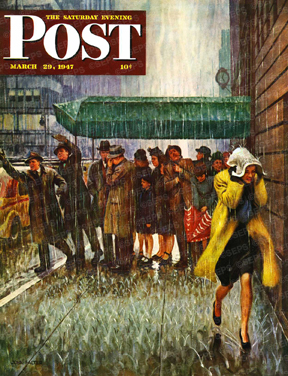 Rainy Wait for a Cab
Rainy Wait for a Cab
John Falter
March 29, 1947
John Falter is one of my favorite Post artists, along with Rockwell (of course) and Constantin Alajálov. Oh, and Stevan Dohanos and Thornton Utz and … well, the point is we’ve had a lot of great artists over the years. This Falter cover is one of his best. It’s so alive and captures the rain, New York City, and the ’50s so well.
April Fools’ Day
Tomorrow is the day we surprise and annoy our friends and family with pranks and jokes and hope they don’t retaliate in some way. One of my favorites is to stand in front of someone and point to their chest, and when they look down, flick their face with your finger (all adult men are still 11 years old inside).
This is usually where I give links to recipes for a food holiday so I looked around the web to see if there was such a thing as food to make for April Fools’ Day … and there is! Taste of Home has a bunch of recipes for foods you might not expect, such as this cake that’s actually meatloaf, this sunny side up egg on toast that’s actually a dessert, and this sushi for kids that’s actually made with Fruit Roll-ups, licorice, and marshmallows.
Because, really, who would want to eat actual sushi?
Next Week’s Holidays and Events
National Humor Month begins (April 1)
I think every month is National Humor Month, but April is the start of the official month of laughing, and there’s even an official site for it. When you’re done there, come back here and browse our humor section.
International Children’s Book Day (April 2)
This day was started in 1967 by iBbY, the International Board on Books for Young People. The day is timed on or around the birthday of author Hans Christian Anderson.
News of the Week: Chuck Berry, Changes with Monopoly, and Costly Comma Mistakes
RIP Chuck Berry, Jimmy Breslin, Chuck Barris, David Rockefeller, James Cotton, Derek Walcott, Colin Dexter, Lawrence Montaigne, Robert Day
What else do you need to say about Chuck Berry except that he was one of the inventors of rock ’n’ roll? When you think of rock in the ’50s one of the songs you think about is probably “Johnny B. Goode,” later made famous for a younger audience in Back to the Future. His other classics include “Rock and Roll Music,” “Sweet Little 16,” “School Day,” “No Particular Place to Go,” and many others.
Berry died Saturday at the age of 90. He has a new album coming out on June 16. It’s his first in 38 years, and it’s titled Chuck.
If Berry was the classic rock ’n’ roller then Jimmy Breslin was the classic newspaperman. The Pulitzer Prize winner wrote a column for The New York Daily News for 50 years, focusing on the everyday workers of New York City. It’s a cliché to say that we probably won’t see another guy quite like Breslin, but we probably won’t see another guy quite like Breslin. He wrote for The Saturday Evening Post too, including this 1965 humor piece about credit cards and this account of Jackie Kennedy’s final moments with JFK in Dallas.
Breslin passed away Sunday at the age of 88.
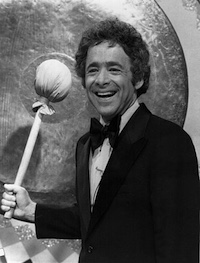
You’ll remember Chuck Barris as the host and creator of the bizarre ’70s game show “The Gong Show.” He also produced “The Dating Game” and “The Newlywed Game” and wrote a book, Confessions of a Dangerous Mind, that became a movie directed by George Clooney and starring Sam Rockwell as Barris. He passed away Tuesday at the age of 87. A new version of “The Gong Show” is coming to ABC.
Barris was also a songwriter and wrote a song you might remember.
David Rockefeller was a billionaire, philanthropist, banker, and member of one of the country’s most famous families. He ran the family bank, Chase, for many years, and along with his brother Nelson, governor of New York, was instrumental in getting the World Trade Center towers built. He was the grandson of Standard Oil founder John D. Rockefeller. He died Monday at the age of 101.
James Cotton was a legendary blues harmonica player who performed and recorded with Muddy Waters, Howlin’ Wolf, B.B. King, Santana, the Grateful Dead, Keith Richards, and many others over his seven-decade career. He passed away last week at the age of 81.
Derek Walcott was an influential Caribbean poet who won the Nobel Prize in Literature for his work. He died last Friday, March 17, at the age of 87.
Colin Dexter created the popular detective Inspector Morse, hero of a series of popular books and TV series. He passed away this week at the age of 86.
Lawrence Montaigne was an actor who appeared on several shows, including two episodes of the original Star Trek, where he played both a Vulcan and a Romulan. He was actually going to replace Leonard Nimoy in the second season if Nimoy had accepted an offer to join Mission: Impossible, but Nimoy decided to stay (he joined Mission: Impossible when Star Trek ended). He also appeared on shows like Batman, The Outer Limits, Lassie, I Spy, The Fugitive, and Dallas, as well as movies such as The Great Escape. Montaigne passed away last week at the age of 86.
Robert Day was a veteran movie and TV director. He directed the films First Man into Space, The Haunted Strangler, Two-Way Stretch, along with four Tarzan movies, and TV shows like The Adventures of Robin Hood, The Buccaneers, The Avengers, The Invaders, The F.B.I., Bracken’s World, The Streets of San Francisco, and Matlock. He died last Friday at the age of 94.
How Does a Thimble Become a Dinosaur?
I haven’t played Monopoly in years, but like most people I wanted to be the race car. I mean, who, if given a choice, would want to be the thimble? Maybe someone who sews.
If you didn’t care for the thimble, you’re in luck. After a poll, Parker Brothers has replaced that piece, along with the wheelbarrow and the boot. Instead of those pieces — hey, I kind of liked that boot! — we’re going to see a T-Rex, a rubber duck, and a penguin (and no, I have no idea why they call it a “rubber” duck and not just a duck). They’ll join the surviving pieces: the car, the dog, the top hat, the battleship, and the cat, so you might have a dinosaur and battleship square off, which I’m sure will be the basis for that Monopoly movie.
And if a big-screen film isn’t enough for you, the board game is also going to be musical.
‘Daniel at Breakfast’
I’m reading a book of essays by Phyllis McGinley titled Sixpence in Her Shoe. It came out in 1963 and was a response to what people like Betty Friedan and other feminists were saying and publishing at the time. McGinley was a housewife and proud of it, and actually celebrated domesticity and suburban life. She also happened to be an acclaimed poet, winning the Pulitzer Prize in 1961 for her collection Times Three and writing several children’s books and poetry for The New Yorker, The Atlantic, and she wrote quite a bit for The Saturday Evening Post. It’s a shame that her books have gone out of print and she’s pretty much forgotten now (even though she was on the cover of Time at one point). But one of her books is remembered and celebrated every December: She wrote the original story for The Year Without a Santa Claus, the basis for the animated holiday TV classic of the same name.
Her birthday is March 21, which also happens to be World Poetry Day. On that day CNN anchor Jake Tapper posted this on Twitter. I don’t know much about poetry, but I like McGinley.
A poem by Phyllis McGinley, born on this day in 1905. #WorldPoetryDay pic.twitter.com/KUIikWk5mk
— Jake Tapper (@jaketapper) March 21, 2017
The Dangers of Not Using the Oxford Comma
We’ve all read examples of how omitting an Oxford (or serial) comma can lead to misunderstandings. One of my favorite examples is on a Tails magazine cover from a few years back that had the headline “Rachael Ray Finds Inspiration in Cooking Her Family and Her Dog.” They didn’t just forget that last comma, they forgot all of them — which makes me not want to eat at Rachael Ray’s house.
Forgetting it can also cost you a lot of money, which a Maine dairy company found out this week. Three truck drivers looking for overtime compensation filed suit against the company and could win a judgment of up to $10 million because of the way a contract was written.
Meet Julia
The iconic children’s show Sesame Street has debuted a new character. She has orange hair and her name is Julia. She also happens to be autistic.
I grew up watching Sesame Street and I learned a lot from it, not just basic knowledge like words and math and why some puppets like to live in trash cans, but also how to treat people. A character like this could really help kids understand.
Julia was already a character in Sesame Street books and stories, and producers decided to also add her to the TV show, which now runs first on HBO and then on PBS several months later.
This Week in History
Patrick Henry’s “Give Me Liberty” Speech (March 23, 1775)
Here’s the full text and the story behind Henry’s famous “Give Me Liberty or Give Me Death!” speech. It was given at St. John’s Church in Richmond, Virginia.
Harry Houdini Born (March 24, 1874)
When I was a kid I was obsessed with Harry Houdini. I read every book I could find on the magician, and at one point even thought of becoming a magician like Houdini (without all of the “escape from a milk container filled with water while handcuffed” stuff). Check out Saturday Evening Post Archives Director Jeff Nilsson’s article on Houdini and “The Art and Crime of Illusion.”
This Week in Saturday Evening Post History: First Crocus Cover (March 22, 1947)
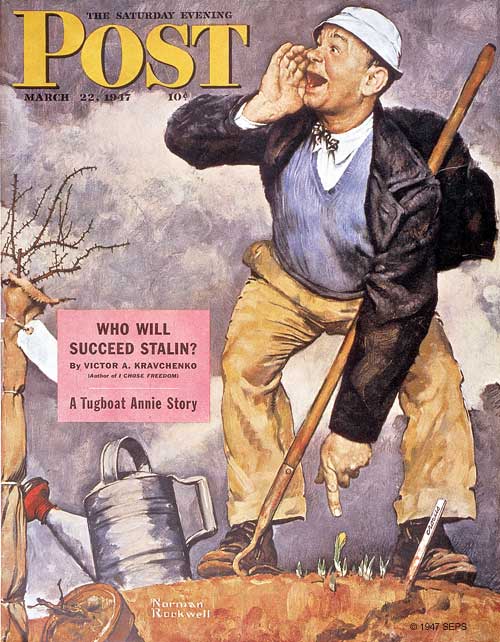
Norman Rockwell
March 22, 1947
I’m not entirely sure what a “crocus” is. It almost sounds like a car. Introducing the Ford Crocus, new for 2017! Anyway, 50 years ago this week the Norman Rockwell work appeared on the cover of The Saturday Evening Post. Read the story behind the cover here.
Pecan Day
Pecans? Not a fan. Almonds? Sure. Peanuts? Yup. Cashews? Great! But I never got a taste for pecans, really. I was going to make a joke that someone should do an ad campaign for pecans with the slogan “YES PECAN!” but something like that already happened.
Tomorrow is Pecan Day. Here’s two recipes for shortbread cookies that include pecans, and here’s one for a crunchy sweet potato casserole.
Maybe I’ll try these sugar-coated pecans. Even though I’m not a pecan fan, I find that most things are improved when you cover them in sugar.
Next Week’s Holidays and Events
National Doctors’ Day (March 30)
This is the day when we honor the men and women who keep us alive. If you happen to have an appointment on this day, maybe you can bring your doctor some of those sugar-coated pecans.
World Backup Day (March 31)
If you’re like me, you often forget to back up the files you have on your computer (I once lost an entire novel I wrote because I didn’t have another copy). Today’s the day to remember to do that. Well, every day is the day to remember that, but maybe after an official day to remind us, we’ll actually start doing it. And I don’t mean just a cloud backup.
Motoring Milestones: How Many of These Facts About the Early Automobile Do You Know?
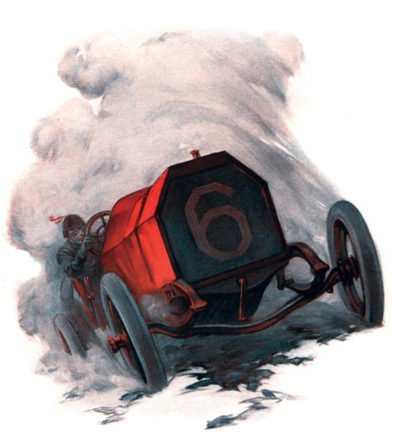
Automobile Racing
Fousey
October 23, 1909
Motoring milestones and other features about the early automobile can be found in the Post’s Special Collector’s Edition: Automobiles in America!
The Inventors
1885
Click it. Edward J. Claghorn of New York receives patent for seat belt.
1887
It still spills all over his shoes. First gas pump is patented by one Sylvanus Freelove Bowser.
1891
Range: 50 miles. Top speed: 20 mph. First successful electric car built in U.S. by William Morrison.
1895
Gasoline firsts. Duryea Motor Wagon Company is earliest company formed to build gas-powered cars. (But Winton claims first auto sale).
1896
Officer, I didn’t see her coming. In the first recorded auto accident, a Duryea Motor Wagon strikes a woman on a bike, breaking her leg. Driver spends night in jail.
1898
Going without the “Flo.” First auto insurance policy is purchased by Dr. Truman Martin of Buffalo, New York. $5,000 in liability coverage costs him $12.25.
Doing the best they can. New York City Police Department uses bicycles to chase speeding motorists.
1901
Rules of the road. Connecticut enacts first speed limit law for motorists — 12 mph in the city and 15 mph on country roads.
1903
A real adventure! Horatio Nelson Jackson and Sewell K. Crocker are first to drive cross country. 64-day trip is made in Winton Touring Car.
What’s in a number? Massachusetts is first state to issue license plate. It’s made of porcelain.
I can see clearly now. Inventor Mary Anderson develops first windshield wiper. Manual device is operated by a handle. Automatic wipers would arrive in 1917.
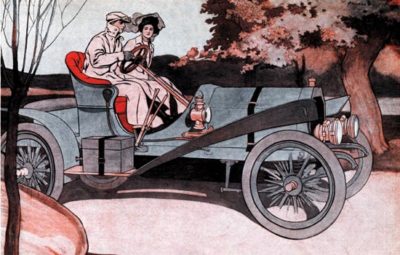
Oldsmobile advertisement originally appeared in the Post on May 5, 1906
1904
Pull over! First paper speeding ticket is issued in Dayton, Ohio, to Harry Myers for going 12 mph in a 5 mph zone.
Pull over, part deux. U.S. surpasses France in car production.
1905
Temptation for speedsters. H.H. Buffum produces first American V8.
Dirty rags and all. First purpose-built U.S. gas station is recorded in St. Louis.
1909
POTUS gets a lift. The first official White House car is a 1909 White Steamer, ordered by President Taft, over congressional objections about cost and safety.
Ahead of her time. 22-year-old Alice Ramsey is first woman to drive cross country. Trip is made in Maxwell DA touring car and takes 59 days.
The Innovators
Birth of a classic. The first running of the Indy 500. Winner Ray Harroun averages 74.6 mph.
Watch out behind you! The first rearview mirror is used by Harroun in Indy 500. (Other drivers placed their mechanic in the backseat to keep an eye out for cars coming from behind.)
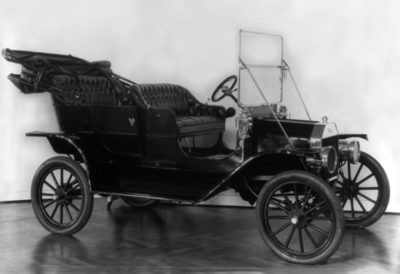
Model-T
1913
Chevrolet makes its marque. The iconic bow-tie emblem appears for the first time on 1914 models.
1914
Hard bodies. Dodge introduces first car body made entirely of steel.
Cadillac produces its signature V8. Known as the L-head, the engine is first mass-produced, water-cooled V8.
It’s a machine, but you have to obey it anyway. Cleveland installs first electric traffic light.
1915
Noise ordinance to follow. The first car to get the horn button in the center of the steering wheel is the Scripps-Booth Model C. In another first, the car sports electric door latches.
Now that’s power! Packard’s Twin-Six is first production car to offer a V12. The car, used in Italy during WWI, would later inspire Enzo Ferrari to design a V12 of his own.
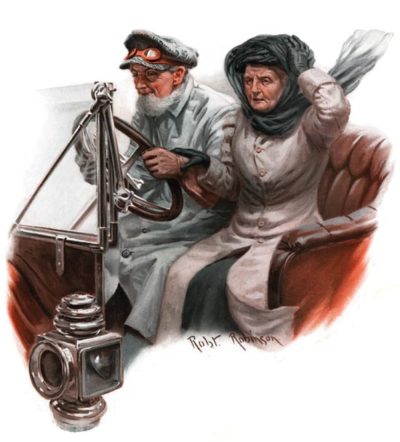
Robert Robinson
January 11, 1913
1916
Federal Aid Road Act. President Wilson signs law giving federal aid for state highway costs.
Ford leads the way. As prices drop and production surges on the Model T, Ford captures 55 percent of the auto market. The record has never been beaten.
1918
Stop, go, and huh? First tri-color stoplight is installed. In Detroit, of course.
Cars for All
1921
Design fails to include arches. The first drive-in restaurant in the U.S., J.G. Kirby and Reuben W. Jackson’s Pig Stand, opens in Dallas.
No umbrella? No problem. Hudson introduces the Essex Coach, the first affordable enclosed sedan, marking the beginning of a shift away from open vehicles. By the end of the decade, nearly 90 percent of all cars feature a closed carriage.
1922
Huge difference in stopping power. The Duesenberg is first to offer four-wheel hydraulic brakes.
Finally, a car for the whole family. The first production station wagon is offered by Star, a division of Durant Motors.
They didn’t reckon on Howard Stern. The radio is offered as an accessory for the first time.
1925
Sleepover date! First motel opens in San Luis Obispo, California.
Dogs and kids in the back. The first factory-assembled pickup truck is based on the Model T, but with rear cargo box. It sells for $281.
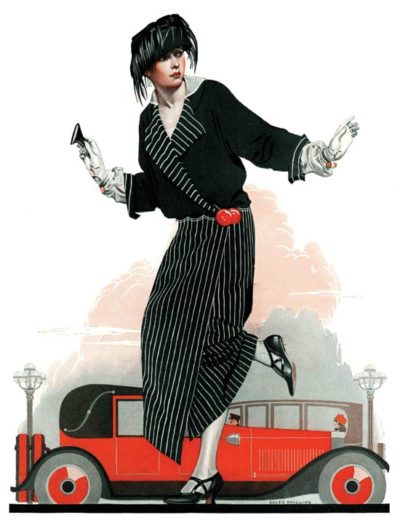
Coles Phillips
September 23, 1922
1926
Easy turning. Pierce-Arrow is first to be outfitted with power steering.
1927
15 million sold. The Model T, by the end of its run, hits a sales milestone.
New kid in town. Ford replaces the Model T with its (second) Model A, powered by a four-cylinder 40 hp motor. The car sports innovations such as safety-glass windshield, roll-up side windows, and three-speed transmission.
1928
Lincoln Highway completed. First road to span America, running from New York to San Francisco.
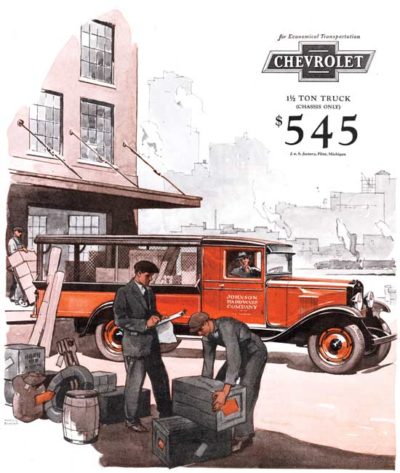
Chevrolet advertisement originally appeared in the Post on August 3, 1929
The Classic Era
1930
Power surge! Cadillac 452 series is first production V16.
Hey! Slow down! There is still no speed limit in 12 states.
Whiz kid. Billy Arnold crosses 100 mph barrier at Indy 500: average speed 100.448 mph.
Anything for the record books. Charles Creighton and James Hargis drive roundtrip from New York to Los Angeles using only reverse gear. The trip, in a Ford Roadster, takes 42 days.
1932
Bigger is better! Ford introduces its famous flathead motor. The V8 becomes an option in the Model B and 18. Later that year it becomes an option in Ford trucks.
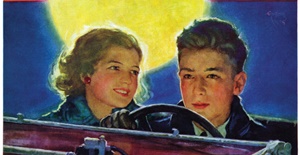
Moonlit Car Ride, Eugene Iverd, January 7, 1933
1934
No such thing as bad publicity. Bank robbers Bonnie Parker and Clyde Barrows endorse the 1934 Ford Model 730 Deluxe Sedan: “I have drove Fords exclusively when I could get away with one. It has got every other car skinned, and even if my business hasn’t been strictly legal it don’t hurt anything to tell you what a fine car you got in the V-8.” Ford responds with thank-you note.
1935
The original one-armed bandits. The first parking meters go into service in Oklahoma City.
Strength in numbers. United Auto Workers union is formed.
The hard part is remembering to switch them off. Flashing turn signals introduced. (They become standard on Buicks in 1938.)
1936
Rig Leader. Ford is tops in truck sales with 3 million units sold.
1937
Song to follow. Route 66 completed.
1939
Look ma, no hands! GM introduces first fully automatic transmission, the Hydra-Matic Drive, in its 1940 Oldsmobile models.
Bill Murray Wants to Play

Courtesy Netflix
You are standing on a corner in New York City, waiting to cross the street. Lost in thought, you aren’t paying much attention to the world around you. Suddenly, a man puts his hands over your eyes and says, “Guess who?”
Nobody’s played this game with you since elementary school. It would be alarming, except that the voice is familiar. You can’t quite place the speaker, but you’re pretty sure he’s a friend.
You whip around and see, much to your surprise … international film star Bill Murray. He is taller than you expected, and his shirt is wrinkled. You sputter, groping for words, unable to process the unlikelihood of this situation. Bill grins, leans in close, and quietly says, “No one will ever believe you.”
Variations on this story began to circulate widely around 2010. Sometimes it happened in New York, sometimes in Austin, Texas, or Charleston, South Carolina. Sometimes Bill wasn’t blindfolding people with his fingers — instead, he was stealing a french fry off somebody’s plate or grabbing a handful of popcorn from a stranger at a movie theater. But the punch line was always the same, underscoring that this encounter was an eruption of surrealism on an otherwise ordinary day, meant to be enjoyed for a few flickering moments: “No one will ever believe you.”
For years, it was unclear whether this was something that Bill Murray actually did, as part of a personal campaign to make the world a better, odder place, or whether it was an urban legend that had grown large enough to have its own zip code. Asked point blank about it in a magazine interview, Bill artfully managed not to unravel the mystery. “I’ve heard about that from a lot of people,” he said. “A lot of people. I don’t know what to say. There’s probably a really appropriate thing to say. Something exactly and just perfectly right.” Bill considered the rhetorical tightrope he was walking, and then he smiled: “But, by God, it sounds crazy, doesn’t it? Just so crazy and unlikely and unusual?”
January/February 2016 Limerick Laughs Winner and Runners-Up
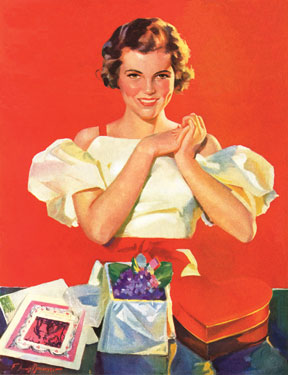
This girl has a radiant smile,
And it seems she has savvy and style.
This was Valentine’s Day.
No one sent gifts her way,
So she bought them and selfied the pile.
Congratulations to contest winner Deborah Dickinson-Deacon of Amherst, New York! For her limerick describing F. Sands Brunner’s illustration, Valentine’s Gifts (above), Deborah wins $25 and our gratitude for an entertaining poem. If you’d like to enter the Limerick Laughs Contest for our next issue of The Saturday Evening Post, submit your limerick through our online entry form.
Deborah’s limerick wasn’t the only one we liked. Here are some of our other favorite contest entries, in no particular order:
For me? Well, I’m just pleased as punch.
The problem: I don’t have a hunch
Who the gift could be from.
Let’s hope not that bum —
Fred Bruner — who stuck me with lunch.—L.J. Williams, Topeka, Kansas
Valentine gifts are such fun,
No matter how often they come.
I will save them and then
I’ll thank the young men
Just as soon as I know who they’re from.—Alfred W. Cross, Sacramento, California
Although she’s aglow with her heart,
It really would give her a start
To know that her flower
And mini card shower
Were a last-minute thought at Walmart.—Kevin Rorabaugh, Ellis, Kansas
Such Valentine gifts make me weep —
A card with a message that’s deep,
Some candy — what’s more,
There’re posies galore.
So where is the jewelry, you creep?—Betty Lyons, Newton Falls, Ohio
This Valentine babe — such a cutie —
Blushed at chocolates and violets as booty.
If she’d known modern taste
To maintain a tight waist
She might have requested tofutti.—Mia Berman, New York City, New York
His girl was utter perfection,
So he sent her a lovely confection.
She blushed chin to locks
When she opened the box
‘Cause he sent her the “lover’s selection.”—J. Janes, Marinette, Wisconsin
Perusing the many entreaties
That came from her various sweeties,
The candy she tried
Came with one downside:
The risk of type two diabetes.—Patrick McKeon, Pennington, New Jersey
I’ve waited all year for this day,
And I’ve only got one thing to say:
While candy is nice,
It just won’t suffice;
I’d rather go roll in the hay!—Michelle Gordon, Airway Heights, Washington
This sweet lass had suitors of three.
There was Harry and Masters and me,
Yet I thought she was mine,
This dear sweet valentine,
Till she ran off with someone named Lee?—Patricia Brinton, Burnsville, Minnesota
News of the Week: Best Years, Branded Sketches, and Bars Made of Meat
The Best Years of Our Lives
When was America at its greatest?
That’s always one of the great dinner party questions. Are we better off now than we were 4, 8, 20, 40, 60 years ago? With Donald Trump’s slogan being “Make America Great Again,” it’s something people have been thinking about. What exactly made America “great” and what time is Trump talking about? The ’40s? The ’50s? The ’90s? Maybe the 1880s?
Morning Consult, a polling service, asked Trump supporters online what America’s greatest year was. Guess the most popular year that was mentioned. Guess! You’ll probably be wrong.
They picked the year 2000, when Bill Clinton was still president and social media hadn’t been invented yet.
Other popular years were 1955, 1960, 1970, and 1985. Now, those are wildly varied eras (and also very rounded years — what, no one liked 1957 or 1989?). There doesn’t seem to be any rhyme or reason to it. Older people probably picked a long time ago and younger people probably picked 2000. It’s almost as if they don’t know what exactly “Make America Great Again” refers to, but they like the sound of it.
I think a lot of people don’t really know when the best years were, they just know it’s not right now (it’s never right now). We have a nostalgic feeling for years ago, and a lot of people don’t understand how we could have liked those times when we had so many problems. Well, name a year or decade when we didn’t have any problems. All eras have great things about them, even the ones where terrible things happened. I think people like times when things weren’t as fast-paced and muddled and changing.
On a personal note, I really loved 1985, when I was 20. I had a fun job with access to pizza and booze, I had less to worry about, and I had so much more hair.
Get Ready to Match the Stars!
From the “things you never thought you’d see again” department comes this news: Match Game is coming back to television. And you’ll never guess who the host is going to be. I’ll give you 1,000 guesses. Never mind, you’ll never guess.
It’s Alec Baldwin! The new ABC show will be part of ABC’s “Fun & Games” block on Sunday nights this summer, along with Celebrity Family Feud and The $100,000 Pyramid. It will be filmed in New York City.
Now comes the fun part: trying to figure out which celebrities will be on the new version. Since it’s ABC, I wouldn’t be surprised if we saw Jimmy Kimmel and Whoopi Goldberg. Personally, I’d love to see Brad Garrett, Craig Ferguson, Anderson Cooper, Tina Fey, and Amy Poehler. And Betty White! We can’t forget Betty White!
What’s your dream cast?
This Part of the Column Is Brought to You by Hot Pockets
Saturday Night Live announced something this week, and depending on how you look at it, it’s a good news/bad news type of thing. First, the NBC show is dropping the number of ads the show will have by 30 percent, which equals two commercial breaks. You may think that’s good news, but you know they have to do something else, right? They’re going to starting having “branded sketches.”
Deadlineembed reports — in an article with a headline that misses the real story — that the show will “bring in sponsored content from advertisers who will partner with the show for branded sketches.” They probably want to get more people to watch the shows live, cut out the commercials, but still get the advertising in. A lot of these spots will be the pre-taped segments that seem to get a lot of viral juice the next day. (By the way, I really, really hate the term viral.)
I’m pretty sure this happened on 30 Rock. Jack ordered Liz to include more of General Electric’s products in the show’s sketches, so they had to write sketches with people suddenly talking about and buying GE dishwashers and ovens. Let’s hope this integration isn’t as clunky as that was. Actually, it might be funny if it was as clunky as that was.
The Founder
With the way that the Internet and social media and pop culture in general are these days, you’d think we’d know about every TV show/movie/album that’s coming up. But sometimes you get an album like Beyoncé’s Lemonade that seems to appear out of nowhere, and maybe even the trailer for a movie you didn’t know they were making.
Here’s the trailer for The Founder, the new film starring Michael Keaton as McDonalds founder Ray Kroc. Looks like fun. It opens August 5.
Introducing the Meat Bar

A “meat bar” sounds like some place men and women might mingle with each other, but it’s actually a new product from Hershey. Yes, the chocolate company is branching out into dried meat protein bars (mmm, doesn’t that sound delicious?).
The bars will be called Krave — which Hershey already uses for their beef jerky products — and will be a mixture of meat and other things like dried fruit and quinoa. The company has also launched a new brand called SoFit, which offers healthy snacks with more familiar ingredients, like almonds and seeds and fruit.
This could work, though they’re really going to have to find a way to market the new bars. Beef jerky is one thing; a bar made of meat is another.
Why are they doing this? Supposedly, sales of chocolate are down. Not in my house!
The Best Commercial Characters of All Time
As I’ve gotten older, I’ve noticed that TV commercials annoy me more than they used to. I didn’t think this would be the case. I thought I’d be more patient and calm when it came to things like this, but there are so many commercials that just irritate the heck out of me — from commercials that are run way too often (all car commercials) to commercials that are illogical and don’t make any sense and actually make me not want to buy the product.
But in general, I actually like TV commercials and advertising (I know, I’m in the minority). And there are some TV commercial characters I like seeing all the time. All the various Geico spokespeople/spokesanimals are fun (amazing how many different regular characters they have — it seems to go against advertising common wisdom). I like that older couple who do the Consumer Cellular ads. I’d watch them do a sitcom. I also like Flo from Progressive. She’s cute, and the commercials are effective.
But who are the best TV commercial characters of all time? Paper lists their eight favorites, and they include Flo and the gecko from Geico. It’s not a bad list because they actually remember some of the classic characters from the ’60s, ’70s, and ’80s, like Rosie (Bounty paper towels), Mr. Whipple (Charmin toilet tissue), and Josephine the Plumber (Comet cleanser). It’s really great to see a list done by someone who actually remembers that there was pop culture before Saved by the Bell (though I could have done without the Dell dude). I’d add more animated characters to the list, like The Jolly Green Giant, Mr. Clean, and some characters from cereal ads.
Since we’re talking about commercials, can someone explain to me why there are suddenly so many commercials for various brands of copper or ceramic pans? I’ve seen at least four different commercials this past week, all different ads for different brands (though they all use the same language and they all seem to do the same exact things). Is there a hostile takeover of the pots and pans industry going on, so that everything we cook with will now be made of copper or ceramic?
I’m just glad there’s finally a pan that can withstand a car running over it. That happens to me all the time.
Today Is Arbor Day

I remember a joke from my childhood: Arbor Day is the day when we celebrate all the ships that come into the ’arbor. I didn’t say it was a good joke.
Here’s the official Arbor Day site, where you can learn more about, well, trees. You can also check out our Tree Planting 101 to help guide you through the process of planting trees. By the way, do kids still play in tree houses? Is that still a thing?
And tomorrow is Independent Bookstore Day. Support your local brick-and-mortar bookstore (even if it is Barnes & Noble). And if you want to combine these two days, it’s easy. Books are made from trees.
Upcoming Events and Anniversaries
Francis Gary Powers’ U-2 plane shot down (May 1, 1960)
The incident and later exchange of American and Russian prisoners forms the basis of the 2015 Steven Spielberg/Tom Hanks film Bridge of Spies.
Lou Gehrig ends streak (May 2, 1939)
The baseball icon’s 2,130 consecutive game streak record was broken in 1995 by Cal Ripken of the Baltimore Orioles.
Joseph McCarthy dies (May 2, 1957)
McCarthy died only a few years after leading the investigation into communists in the U.S. government and tangling with CBS newsman Edward R. Murrow, a story told in the movie Good Night, and Good Luck.
Kent State University shootings (May 4, 1970)
Four student war protesters were shot and killed by Ohio National Guardsmen.
Cinco de Mayo (May 5)
The day is actually not an official holiday in Mexico, though all schools are closed.
Gary Cooper born (May 7, 1901)
Yup, he played Lou Gehrig.
News of the Week: Why 1964 Is Like 2016, How Much David Letterman Has Aged in a Year, and the Case of the Time-Traveling Twins
Confessions of a Republican
From the “the more things change, the more they stay the same” department comes this video. It has been making the rounds the past couple of weeks, and whatever your opinion of Donald Trump is, it’s rather fascinating. If you replace the name Goldwater with Trump, you can see similarities to some of the criticisms Trump is getting in 2016:
By the way, the actor is William Bogert, who has been in many movies and TV shows and is still acting. He was picked for the Lyndon Johnson spot partly because he really was a Republican.
Wait … That’s David Letterman?!
Have you been wondering what David Letterman has been up to since he retired last year? Apparently, he’s been training for the annual Andrew Weil Lookalike Contest. Here he is photographed while out for a run on vacation:
Never retire. https://t.co/bzveJIuYTU pic.twitter.com/8jDdqGgwRM
— Esquire (@esquire) March 23, 2016
RIP Garry Shandling, Joe Garagiola, Ken Howard, and Peter Brown
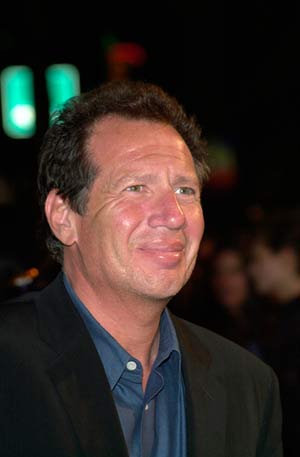
Garry Shandling died suddenly on Thursday. The comedian and writer called 911 himself from his home but collapsed during the phone call. He was found by paramedics but later died at a Los Angeles hospital.
It’s hard to overestimate how much of an impact the late night talk show satire The Larry Sanders Show had on television. It was one of the early must-see shows on premium cable and set the tone for other shows and movies that skewered what happened behind the scenes of a television series. Before Larry Sanders, he starred in the Fox comedy series It’s Garry Shandling’s Show, which, like The Larry Sanders Show, was ahead of its time. As an actor, Shandling appeared in Iron Man 2 and Captain America: The Winter Soldier, Town & Country, The X-Files, Caroline in the City, and other movies and shows, and at the start of his career wrote for Sanford and Son and Welcome Back, Kotter. He was 66.
Just a few months ago, Shandling was a guest on Jerry Seinfeld’s Comedians in Cars Getting Coffee, in an episode eerily titled “It’s Great That Garry Shandling Is Still Alive.”
Well, I feel bad now. Just one week after I wondered why BUZZR had included Joe Garagiola and not John Daly in its new brackets game, word comes that Garagiola has passed away.
He had an incredible career, if you think about it. A baseball player on several major league teams; a sportscaster; a co-host on The Today Show; guest host for Johnny Carson on The Tonight Show; a panelist on shows like What’s My Line?, To Tell The Truth, and Match Game; host of his own game show, He Said, She Said; author of three books, and supporter of many charities and causes. Garagiola passed away Wednesday in Scottsdale, Arizona, at the age of 90. A great life.
Ken Howard also passed away this week. You might remember him as the coach on The White Shadow, as the crazy cable company owner on 30 Rock, and from many other roles. Howard was also the current president of the Screen Actors Guild-AFTRA. He was 71.
Peter Brown was probably best known as the star of the 1960s western TV series Laredo and Lawman, but it’s amazing how many other TV shows and movies he was in, including The Alfred Hitchcock Hour, Magnum, P.I., Wings, Charlie’s Angels, and JAG. He also had regular roles on most of the soap operas over the years, including The Young and the Restless, Days of Our Lives, The Bold and the Beautiful, One Life To Live, and Generations. Brown passed away in Phoenix at the age of 80.
Kraft Mac and Cheese: New Formula, New Spokesman
Speaking of former late-night talk show hosts, I have a confession to make: I liked Craig Kilborn’s stint as host of The Daily Show more than Jon Stewart’s. Well, maybe not more, but certainly just as much. Kilborn has always been derided as the show’s host, with most critics falling all over themselves to praise Stewart. But they hosted very different shows. Stewart skewered politics and the media, while Kilborn’s show was more of a straight comedy/talk show. Both shows were funny in their own way, and I really liked Kilborn’s take. I still wish he hadn’t left CBS’s The Late, Late Show.
I also like Kraft Mac and Cheese, and now the two have finally come together. If you’ve been wondering what Kilborn has been up to the past several years (he really has kept himself out of the public eye), he’s the new spokesman for the boxed pasta, which has gotten a recipe makeover to take out preservatives and dyes. Let’s hope it tastes the same even if it doesn’t look the same. Here’s the new commercial:
Obama’s Trip Reminds Me …
This week, President Obama made the first trip to Cuba by a sitting U.S. president since President Coolidge in 1928. He spoke to the Cuban people in Havana and even went to a baseball game (which was seen as a bad move after the terror attacks in Brussels). But it got me thinking: Havana is a really great movie!
That’s the 1990 Sydney Pollack film with Robert Redford as a gambler who falls in love with the wife of a revolutionary in late 1950s Cuba. It has always been, well, dumped on as a film that’s boring and overlong and tries to be Casablanca but isn’t. It was even insulted in an episode of Seinfeld! I don’t get any of those criticisms, because it’s an incredibly well-acted, engrossing, and beautifully filmed drama. Go stream it — or better yet, buy it because it’s pretty cheap now — and tell me I’m wrong.
What’s Underneath the CBS Broadcast Center?
Mo Rocca guest-hosted CBS Sunday Morning last weekend and did a fantastic job. (Charles Osgood is out for a while after having surgery.) In one segment, he took a tour of the CBS Broadcast Center, the massive New York City studio where the show originates. It’s almost like its own city. There’s also an interesting world beneath the broadcast center that most of the public hasn’t seen until now. And because the show seems to like helping me with the topics I pick for this column, there’s even a section on the aforementioned 1964 Presidential election:
Superman v. Batman v. Superman v. Batman v. Superman v. …
Over at The New Republic, Will Leitch and Tim Grierson rank all of the various Superman and Batman movies, in celebration — if that’s the word for a movie a lot of critics hate — of the release of Superman v. Batman: Dawn of Justice. (That v. should really be a vs.; we’re not talking about a court case here.)
It’s a fine list, and I mostly agree. I’d put the first Superman a little higher and probably wouldn’t put The Dark Knight at number one, but those are minor quibbles. I also like the love for Batman Returns, which I think is an underrated movie. Christopher Walken is great in it, and the movie is like an off-kilter superhero noir.
The Case of the Time-Traveling Twins
If I had an identical twin, I think I would have played a lot of tricks on my family. I mean, what’s the point of looking exactly like someone else if you’re not going to irritate people?
This improv group decided to play a prank on some people, a very public one. They went on a subway and decided to pretend that they were visited by their future selves, who tried to stop their past selves from raising money to build a time machine in the first place. It’s a great idea. I don’t know if the acting is good enough for the other people on the subway to actually believe them (plus it’s, you know, time travel), but you can tell they’re very amused.
It’s probably the greatest thing that has ever happened to these people while riding the New York City subway.
National Make Your Own Holiday Day
There’s a holiday for everything, and I mean everything. National Fluffernutter Day? That’s October 8. National Flip a Coin Day? That’s June 1. And if you like to play the saxophone, set aside November 6. That’s National Saxophone Day.
Tomorrow is National Make Up Your Own Holiday Day. It’s the day you can make up your own special day and celebrate it every single year. So many holidays are already taken, so you have to be a little creative.
With that in mind, I hereby declare that March 26 is now Read An Issue of The Saturday Evening Post While Drinking a Glass of Wine Day. Take a picture of yourself doing it and post it on Facebook or Twitter.
On an unrelated note, tomorrow is also National Spinach Day.
Upcoming Events and Anniversaries
Worst aviation accident in history (March 27, 1977)
It was a runway crash between two Boeing 747s at the Los Rodeos Airport on Tenerife in the Canary Islands in which 583 people were killed.
Julius and Ethel Rosenberg convicted (March 29, 1951)
The couple was convicted of spying and sentenced to death.

Eiffel Tower opens (March 31, 1889)
I bet you’ve always wondered what do your bones have in common with the famous Paris landmark?
President Lyndon Johnson announces he won’t seek re-election (March 31, 1968)
Johnson remarks about not running for a second term came at the end of a speech about the status of the Vietnam War.
April Fools’ Day (April 1)
To celebrate, you can browse this gallery of Norman Rockwell April Fools’ Day covers for The Saturday Evening Post. Or you can just torment your family and friends with a prank. And if you’re a twin, try the time travel prank above.
News of the Week: Rockwell Gets Own Street; McCartney Dissed at Grammys; Inside TMZ
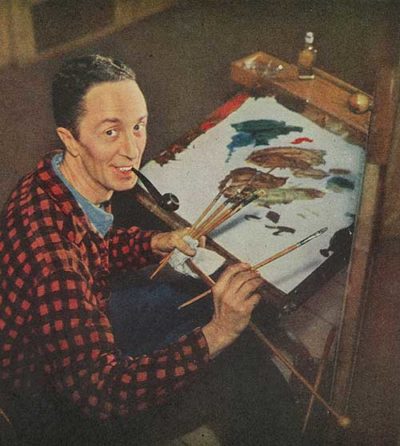
Norman Rockwell the Artist
From February 13, 1943
NYC Street to Be Renamed in Honor of Norman Rockwell
We love the iconic American artist Norman Rockwell here at The Saturday Evening Post, of course. But it turns out that the younger generation loves him too. Thanks to several students at Edward A. Reynolds West Side High School, the southeast corner of Amsterdam Avenue at 103rd Street in New York City is being renamed “Norman Rockwell Place” in honor of Rockwell. The students spent a year on their campaign, doing research, visiting the Rockwell museum in Stockbridge, Massachusetts, and making t-shirts, and they even went around the neighborhood to garner support for the name change.
Paul McCartney Not Allowed into Grammy Party
Let’s say you’re a really famous musician, maybe one of the 4 or 5 most famous musicians in the world. Let’s say you were at the Grammy Awards and you wanted to go to one of the after-parties. Do you think you could get in, or would the bouncer at the front door shoo you away?
That’s what happened to Paul McCartney this week after the Grammy Awards broadcast on CBS. In this video shot by TMZ we see McCartney and Beck being turned away from the Tyga party. Before this, I didn’t know if Tyga was the name of a musician, a band, a company, or a shoe, but they tried to get in and couldn’t. So they went back to their car and drove away.
Speaking of TMZ
Have you ever wondered how the gossip site TMZ always seems to get the scoop on celebrities’ dirty laundry? In this revealing New Yorker article, you’ll find out how they get their information, what they pay for it, and how they sometimes partner with celebrities on certain stories.
Pick Up Organic Carrots, Get a Tattoo
I know it seems like an odd idea, but Whole Foods might be getting into the whole tattooing thing. The grocery chain would partner with third-party vendors to provide tattooing services in their 365 stores, which cater to Millennials.
This could be the start of something. Other chains could get into the act. Going to Dunkin’ Donuts for some coffee? Get your oil changed! Picking up a snow blower at Home Depot? You can get your hair done there, too!
RIP Justice Scalia, George Gaynes, Vanity, Johnny Duncan
I really can’t add anything to the many tributes to Supreme Court Justice Antonin Scalia, who passed away at the age of 79, but for a good summary of his life and what he meant to people, you can read Justice Ginsburg’s touching statement about her friend, a rundown on his legal rulings, and this from The Atlantic on his remarkable life. The New York Times reprints the first mention of Scalia in the paper (when he was 16!), and even Stephen Colbert paid tribute to Scalia on The Late Show.
George Gaynes also passed away this week. He was 98. You might remember him from the TV shows Punky Brewster and The Days and Nights of Mollie Dodd and movies like Tootsie.
You might remember Vanity, aka Denise Matthews, from her work with Prince. She passed away this week too, at the age of 57.
You might not remember the name Johnny Duncan at all, but you’ve probably come across his work. He played Robin in the 1949 Batman movie serial, which TCM sometimes shows. He passed away at the age of 92. Here’s the first episode (and here are the other 14):
And RIP Harper Lee
Friday morning, we lost American novelist Harper Lee at the age of 89. People speak in awe of the tens of millions of copies her To Kill a Mockingbird has sold since it was published in 1960, but more impressive still is the effect the book has had on readers. In a January 2011 Post article called “Does Fiction Matter?” mystery writer Brad Meltzer answered the title’s question with a resounding “Yes” by pointing out a Library of Congress study that said that when asked which books had made a difference in their lives, the only book people cited more often than To Kill a Mockingbird was the Bible.
“Happy Birthday” Lawsuit Settled
I used to joke that you couldn’t sing “Happy Birthday” at a birthday party anymore without paying a royalty to the two sisters who wrote the song and the company that owned the copyright to the lyrics. Turns out that wasn’t true; you only had to pay for a public performance of the song. But no one has to pay now, because a federal judge has ruled that Warner/Chappell Music actually doesn’t own the rights to the lyrics. Under a deal, the record company will return $14 million in fees it had charged, and it will also no longer charge for the song’s use.
Warner/Chappell actually made over $2 million a year from the song. Every time I hear stories like this, I think of this scene from an episode of Sports Night:
National Grapefruit Month
It doesn’t seem right to have February be the month we celebrate the grapefruit, when it’s more likely to be cold and windy and we’re using the snow blower we just bought at Home Depot. But it’s here, and you still have a couple of weeks to celebrate. We know it’s good for your health — though you should make sure it doesn’t interfere with any medications you’re taking — and it’s a lot more flexible when it comes to recipes than I thought.
But Martha Stewart has you covered. (She always has you covered.) Here’s a recipe from Martha for jicama-citrus salad, one for a ginger-grapefruit spritzer, and one for grapefruit with pistachios. And have you ever thought about putting grapefruit in a sandwich? Of course you haven’t. But Martha has!.
Upcoming Events and Anniversaries
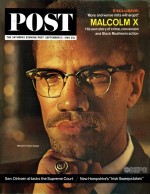
Malcolm X killed (February 21, 1965)
The leader appeared on the September 12, 1964, cover of The Saturday Evening Post.
President George Washington born (February 22, 1732)
Washington appeared on the cover of The Saturday Evening Post ten times.
House of Representatives votes to impeach President Johnson (February 24, 1867)
Johnson’s impeachment trial lasted 11 weeks.
Buffalo Bill Cody born (February 26, 1846)
Here’s SEP Archives Director Jeff Nilsson on “America’s First Superstar.”
Henry Wadsworth Longfellow born (February 27, 1807)
The poet’s work appeared many times in The Saturday Evening Post.
News of the Week: Darth Vader, Distraction, and the Diet of Tom Brady
Star Wars: The Force Awakens
I can’t believe it’s the end of October already. Christmas will be here before you know it. And that’s when the new Star Wars sequel opens, on December 18. Here’s the official trailer:
Fans already have their theories about the trailer. People are examining it more than the Zapruder film. There’s Darth Vader’s helmet! Why is Leia crying? Hey, why does that character have that light saber? The big question is: where’s Luke? He doesn’t seem to be on the poster, and he might not even be in the trailer, though that might be him at 1:40, his repaired hand on R2D2. There must a reason for the secrecy involving the character. Does he look different? Is he in hiding? Has he (gulp) gone over to the dark side and is now the bad guy?
Io9 has a shot-by-shot breakdown of the trailer, which debuted during Monday Night Football, which made some fans unhappy. If you’re the type who likes to argue about things, you can read why some people want you to boycott the film because it’s “anti-white”.
If you plan to see it on opening day, you’re not alone. Believe it or not, fans are already buying tickets. May the Fandango be with them.

The Age of Distraction
Many people are under the impression that because of all of the technological advances we …
I’m sorry, I had to check my e-mail. What was I saying?
Oh yes, distraction. Sure, we’ve always found things to help us kill our attention spans, but not at the level we do now. We’ve been programmed to believe that multi-tasking is actually a good thing, and we can do everything everywhere now because we carry our phones, our mail, our files, our TVs, our music, and our computers around with us in our pockets 24/7. There’s no downtime anymore. We’re always “on” and there’s always something new to distract us.
The new book The World Beyond Your Head by Matthew B. Crawford, argues that, as The Los Angeles Review of Books says, “we are living through an unprecedented crisis of attention.” And as a simple test, see if you can get through that entire review without getting antsy or skimming it or clicking away. A lot of people are having trouble reading anything longform now, because we’ve gotten so used to short social media posts and texts and smartphones and other forms of quick gratification.

 The Typewriter Revolution by Richard Polt
The Typewriter Revolution by Richard PoltThe Typewriter Revolution
One thing you can do if you find yourself easily distracted is … buy a typewriter! This is a particularly good idea if you’re a writer and you don’t want to be distracted by email and Facebook and the latest news and games and various alerts and just want to concentrate on the words on the page. Sure, you can’t surf the Web on a Smith Corona — and the only “app” you might use is Wite-Out — but that’s kinda the point.
The Typewriter Revolution is a new book by typewriter expert and historian Richard Polt. In it, Polt not only explains how to choose the best typewriter and care for it, but he delves into the history of the machines, the famous people who used them in the past and the people who use them now, from novel writers to people who have typewriter blogs and host Type-In social events.
There’s a typewriter renaissance that’s been happening the past few years. Younger people are starting to love the machines because it’s not another screen they have to look at, and many people are discovering that unlike computers, they don’t get obsolete or break down or become disposable. Also, typewriters are works of art with different personalities.
Maybe we should thank Tom Hanks for the renewed interest in typewriters. He collects them and even created the Hanx Writer iPad app to bring the machines into the 21st century.
The Tom Brady Diet
A great philosopher, I think it was Aristotle, once said, “Don’t trust anyone who eats kale for breakfast.” And I guess that would include New England Patriots quarterback Tom Brady, who has let us know exactly what he eats and doesn’t eat to keep in shape.
What does he like? Kale for breakfast, raw macaroons, and avocado-based ice cream. What does he avoid? Coca-Cola, which he calls “poison,” and Frosted Flakes, which he implies isn’t food (30:07). Let’s hope Coca-Cola and Kellogg’s don’t advertise at Gillette Stadium.
Doesn’t he know Frosted Flakes are grrrrrrrrrrrrrreat?
October 21, 2015
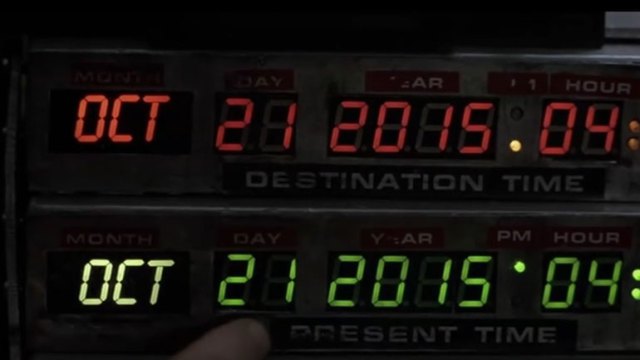
While the Star Wars movies are set in the past (a long time ago…), Back to the Future II was set, at least partly, in the future. October 21, 2015, to be exact. Well, it was the future in the movie. For us, the future is this week.
What did the movie get right in its depiction of 2015 life? Well, we have video-phone calls but still no hoverboards. We have video games that we can play without our hands, like Kinect, but no Jaws 19 (though Universal did create a trailer for it) We have video glasses in the form of Google Glass and virtual reality headsets (though they’re not mainstream yet), but no double neckties (thank God). The Washington Post has a good rundown of what the film got right and got wrong. The movie didn’t predict the Web either, but you can still get a print USA Today.
In the movie, the Chicago Cubs win the 2015 World Series, but … well, sorry, Cubs fans.
If you can’t get enough of all things Back to the Future, there’s a new documentary called Back in Time that includes interviews with the cast and crew and goes behind the scenes of all three movies.
Die Hard 6: An Idea That Should Die Hard
Contrary to popular belief, a movie sequel isn’t always a bad idea. After all, From Russia, With Love was a sequel to Dr. No, and we’ve had several more James Bond sequels since then, and we don’t have a problem with them, right? And everyone loves when there’s a new Avengers or Mission: Impossible, so if they’re well-made, sequels can be really great. Prequels, on the other hand … well, just look at the three Star Wars prequels. Prequels are often bad because they try to act as both prequel and sequel at the same time. If it’s done well, it’s fantastic. If it’s done poorly, then it can put a bad taste in your mouth about the films that came before (after?) it.
But that’s not stopping people from giving us Die Hard 6, which is in the works. What a terrible idea.
The plot? It’s an origin story! We’ll get to see young John McClane (hopefully played by another actor and not Bruce Willis in a bad wig) and the adventures he got into as a young cop in ’70s New York City. Besides the fact the last couple of Die Hard flicks weren’t that great and should have been a sign the series should just go away quietly, the plot goes against what happened in the original. McClane was a Joe Everybody, a non-hero suddenly finding himself in an incredible situation. And now we’re going to go back and see him battling bad guys and saving the day when he was in his 20s? If Willis is in it he might be in scenes in the beginning and end of the film, as an older McClane looking back.
No, no, no, no, no, no, no, no, no, no, no, no, no. Also: no.

October Is National Cookie Month
In honor of the new Star Wars film, how about some cookie recipes centered around characters from the film? Here’s a how-to video on how to make Darth Vader cookies, and here’s a page that shows you how to make R2D2 and light saber cookies. If you want to be really accurate with your cookies, get the Star Wars cookie cutters. You can make a Back to the Future cookie too.
Sorry, I couldn’t find any recipes for Die Hard cookies. If you do, let me know.
Upcoming Events and Anniversaries
Pablo Picasso born (October 25, 1881)
This site says that when it comes to art, Picasso was “probably the most important person of the 20th century.”
Opening of NYC subway (October 27, 1904)
If you don’t live in New York City, its subway system can seem awfully confusing. NYCSubway.org has a lot of great info to make it a little clearer, along with some great historical photos.
Theodore Roosevelt born (October 27, 1858)
After President McKinley was assassinated, Roosevelt became the 26th president of the United States.
Stock market crash (October 28, 1929)
Known as Black Monday, the dark day led to the Great Depression of the 1930s.
Orson Welles’ War of the Worlds broadcast (October 30, 1938)
Here’s the complete audio of the broadcast that many thought was a real newscast and that we were actually being invaded.
Halloween (October 31)
The once fun day has been hijacked by grown-ups and just isn’t the same.
News of the Week: Harry Shearer, Harper Lee, and a Whole Lotta Hot Dogs
Exxxxxcellent

Well, that didn’t last long. Just a couple of months after leaving The Simpsons, veteran voice artist Harry Shearer reached a deal for two more years and will be returning to the show. Sure, they could have probably found someone new to mimic the voices of Mr. Burns, Smithers, Ned Flanders, Principal Skinner, and Reverend Lovejoy (maybe Ted Cruz?), but it just wouldn’t have sounded quite the same.
We’d know.
‘Go Set a Watchman’
Harper Lee’s sequel to To Kill a Mockingbird will be released on Tuesday, and you can read the first chapter today at The Wall Street Journal. You can also join in a discussion of the books on the WSJ Book Club’s Facebook page.
Lee said at a private luncheon last week that she’s excited about the book’s release and always thought it would be published some day.
Am I Supposed to Like Soccer Now?

Congratulations, blah, blah, blah, women’s soccer, blah, blah, blah, etc., etc.
I don’t mean to be one of those people, but I still don’t like soccer. Hey, it’s great that the U.S. women’s team beat Japan this week for the World Cup, and it’s great that the match got terrific TV ratings, and it’s fitting that they’re getting a ticker-tape parade this morning in New York City but … I still don’t like soccer.
On Twitter I started to feel guilty reading all the tweets congratulating the team, many with more exclamation points than anyone should use when you have a limit of 140 characters. If I didn’t tweet something too, was I being a Debbie Downer? Maybe you feel the same way. I’m happy for the team, and I’m happy that other people are happy for them, but it doesn’t mean that I’m suddenly going to start watching soccer now. Sorry!
The World of Amy Schumer
Is there anyone who’s being talked about more right now than comic Amy Schumer? She was once just another comic but suddenly she’s being treated as a combination of Carol Burnett and Lenny Bruce. She has a popular show on Comedy Central called Inside Amy Schumer; she’s on the cover of Glamour; she’s causing controversy because of some of her sketches and comments; she was asked to be the new host of The Daily Show when Jon Stewart steps down but turned it down; and now she has a new movie with Bill Hader that’s getting good reviews. It’s called Trainwreck. Here’s the trailer.
One note about the movie. One of the cast members is Norman Lloyd. You might know him best as Dr. Auschlander from St. Elsewhere, or maybe as the villain who falls from the Statue of Liberty in the great 1942 Alfred Hitchcock thriller Saboteur. He turns 101 in November.
KO KO’d
We found out this week that ESPN host Keith Olbermann was leaving the sports channel once again. Rumors were swirling the past couple of weeks that Olbermann’s contract negotiations weren’t going well because execs at the network wanted him to “tone down” his commentary during Olbermann. Who knows if that was even true (the network says it wasn’t) or if it’s the reason why he and ESPN are parting ways? The news was first reported by reporter Jim Miller on Twitter:
The second @KeithOlbermann era at @espn has come to a close. There will be no new contract. Current deal which was two years ends 7/31.
— James Andrew Miller (@JimMiller) July 8, 2015
This was "business decision" from @espn pov; want parting with @KeithOlbermann to be amicable.
— James Andrew Miller (@JimMiller) July 8, 2015
So what will Olbermann do now? Let the betting begin. He could easily show up on another sports program, or maybe we might even see him back at MSNBC, which he left in 2011 after hosting the news show Countdown for several years. Hey, stranger things have happened (like Olbermann going back to ESPN after leaving the first time). With MSNBC not doing too well, having Olbermann go back to where he was successful might be a good thing for both. With Olbermann and Brian Williams at the news channel, things could improve ratings-wise.
Introducing Oreo Thins!
“Thin” and “Oreos” aren’t usually words you’d see next to each other, but this week we had the debut of Oreo Thins, which is a healthier (ahem) alternative to the classic cookie we’ve all loved for over 100 years. They’re thinner than regular Oreos, and they’re healthier (ahem) because four of them have 140 calories, compared to the 160 calories of three regular Oreos. So now Oreo has a cookie for everybody: regular, regular cookies with different frosting flavors, different cookie flavors, DoubleStuf, Oreo Minis, and now Thins.
The new cookies are so thin that you can’t do something you can do with the regular ones: Split them open and lick the frosting inside. You can, but they’ll usually break. So since you’re not taking the time to separate the cookies, you’re probably just going to mindlessly gobble the thinner cookies, which means the thinness and lower calorie count won’t even matter. Though I guess you could dunk them in skim milk and feel better about it. Neil Patrick Harris likes them!
Oreo says the new thinner cookies are more “sophisticated.” I know I always feel more grown-up and sophisticated when I have a bunch of chocolate cookie bits all over my teeth.
National Hot Dog Month

This is the time of hot dogs, a food you can probably categorize as “unsophisticated.” Last weekend we saw a big upset at the annual Nathan’s Hot Dog Eating Contest in Coney Island. 23-year-old Matt Stonie ended Joey Chestnut’s 8-year reign by eating 62 hot dogs (with buns!) in 10 minutes. I’m getting kinda gaggy just thinking about that.
It’s also National Hot Dog Month! How can you possibly do something different in the preparation and cooking of hot dogs that hasn’t been done before? So instead of a recipe, how about taking a look at Serious Eats, where they list 13 signature drinks from various regions to pair with hot dogs? You’ve probably heard of drinking tropical drinks at Papaya King and Gray’s Papaya in New York, but in New Jersey and Virginia you could have one with some buttermilk.
I wonder if there is a Joey Hotdog somewhere, and every year he enters a chestnut-eating contest?
Upcoming Events and Anniversaries
Live Aid concerts (July 13, 1985)
This is the 30th anniversary of the two concerts held in London and Philadelphia to aid in the fight to end hunger in Ethiopia.
Bastille Day (July 14)
Officially became a national holiday in 1880 France.
Billy the Kid dies (July 14, 1881)
This site has an exhaustive amount of information on the famous outlaw, including rare photos and letters he wrote.
“Catcher in the Rye” published (July 16, 1951)
J.D. Salinger’s classic comes in at number 72 on The Guardian’s list of the 100 Best Novels of All-Time.
Disneyland opens (July 17, 1955)
SEP Archives Director Jeff Nilsson on the early days of the Disney dynasty.
Erle Stanley Gardner born (July 17, 1889)
The TV show based on Gardner’s famous character Perry Mason was on the air during the supposed “vast wasteland” of programming in 1961.
News of the Week: The Real Shakespeare, Real Reporters, and the Real Thing
Is This What Shakespeare Really Looked Like?

The biggest mystery about William Shakespeare used to be the theory that it was actually Sir Francis Bacon that wrote the plays the Bard is famous for. Now there’s another controversy: Has the real face of Shakespeare finally been found?
Honestly, I didn’t even know that this was a mystery. I always thought we knew what Shakespeare looked like. Of course, I’m basing this on years and years of TV shows and movies, but I had no reason to think that it wasn’t accurate. But now botanist and historian Mark Griffiths says in Country Life that the image found in a 17th-century book on botany is the “first and only known demonstrably accurate portrait” of Shakespeare.
Of course, a lot of other historians aren’t convinced. Not only is this not the first time someone has claimed to find the “real” image of Shakespeare, this image was found in a book on botany, and some people don’t know why he would have been in such a book.
Can a Machine Replace a Reporter?

One day, everything you read online and maybe even offline (if there is such a thing as offline in the future) will be written by a computer program. Well, okay, maybe not, but it’s not like news organizations aren’t trying.
There are companies creating programs and apps that actually write some of the news stories you read on Yahoo! and the Associated Press. A reporter for NPR, Scott Horsley, decided to challenge one of these programs — with the friendly, innocuous name WordSmith — to see who could write the story quicker and if anyone could tell the difference. Here are the results.
I find this a scary development. Not just the fact that real reporters could see their jobs taken away some day, but also the fact that people think the style and personality of a writer can be duplicated 100 percent. I guess it’s the speed and information they see as the important thing, and it’s only being used for certain stories right now. If this does happen, in 50 years we’ll just be a race of people that consumes news but doesn’t write any of it.
Of course, you have no idea if this very column is being written by … BUFFERING BUFFERING … a computer program. There’s really no way you can tell 01010101010101010101010101010 is there?
The ‘Mad Men’ Finale Explained
It has become commonplace to announce in a review or essay about a TV show that there are spoilers about to be revealed. I’ve never understood that, because if I’m reading a review of a TV show I’m just going to assume that, you know, what’s in the TV show is going to be revealed. Having said that, SPOILERS FOLLOW SO RUN FOR YOUR LIVES IF YOU HAVEN’T SEEN THE MAD MEN FINALE YET.
At the end of the episode, we see Don Draper, who has left everything and everyone behind, meditating on top of a hill in Northern California with several other people in an Esalen-ish retreat. Don has his legs crossed and is in the middle of an “oooooooooommmmm” chant when the camera comes in on his face and he smiles knowingly. We hear a “ding” and immediately the classic “Hilltop” Coca-Cola commercial comes on the screen. End of show.
I think it’s pretty clear what happens: Don gets the idea for the commercial, realizes who he is, and goes back to New York City and creates the ad for McCann Erickson. It’s a positive, non-cynical ending. But so many people online, both critics and casual fans, are seeing the ending as not only cynical and defeatist but also ambiguous. You mean Don learned nothing and goes back to advertising? Does Don create the ad or is it Peggy? Does Don stay at the retreat and change his life again? Is the ad just thrown on the screen because it was released around this same time and involved a hillside full of people and has nothing to do with Don?
Honestly, I think the ending we see is the ending we got. Shows like Lost have changed the way we watch television and what we expect from a series finale, and not for the better. There’s not always a “mystery” to what we see. We have to judge the ending by the information we’re given. It’s almost as if fans and critics are writing some sort of Mad Men fan fiction to “explain” the ending, envisioning what the scene really means and what happens 30 minutes, 30 hours, 30 days after Don smiles. Sure, a lot of things could have happened, but how are we to know? We have to judge it by what happened in the episode (and in the other episodes this season).
For the record, Mad Men star Jon Hamm agrees with me.
And creator/writer Matthew Weiner clarified the ending in a talk with writer A.M. Homes at the New York Public Library on Wednesday night, saying he’s “not for ambiguity for ambiguity’s sake” and (talking about Don and the Coke ad) “the idea that someone in an enlightened state and not just co-option might have created something that is very pure.”
‘Steve Jobs’ Teaser Trailer
Another highlight of the Mad Men finale was the debut of the first trailer for Steve Jobs, the biopic of the Apple Computer guru directed by Danny Boyle and written by Aaron Sorkin (The West Wing, The Social Network). Interesting that for the trailer they’re showing latter-day Jobs with the lighter hair and not younger Jobs:
National Wine Day

I’m a red wine guy. The few times I’ve had white I’ve regretted it and I’ve run back to my Cabernet Sauvignons. But for this Monday, National Wine Day, I’ve decided I’m going to try to get into white wine. I want something light, something smooth, something that won’t scare me off, something very drinkable. Any suggestions?
And by the way, don’t confuse National Wine Day with National Drink Wine Day, which is February 18. I don’t know what the difference is (is there something else you can do with wine besides drink it?), but there you go.
Upcoming Anniversaries and Events
The Indianapolis 500 (May 24)
This is the 99th race held at the Indianapolis Motor Speedway.
First Major League Baseball night game (May 24, 1935)
There were baseball games played at night before 1935, but this was the first official Major League Baseball game played under the lights.
Brooklyn Bridge opens (May 24, 1883)
Today is the 131st anniversary of the opening of the iconic New York bridge.
Bram Stoker’s Dracula published (May 26, 1897)
You can read the classic horror novel online for free at Project Gutenberg.
Golden Gate Bridge opens (May 27, 1937)
The official site has a complete history of the bridge and information if you’re thinking making a visit.